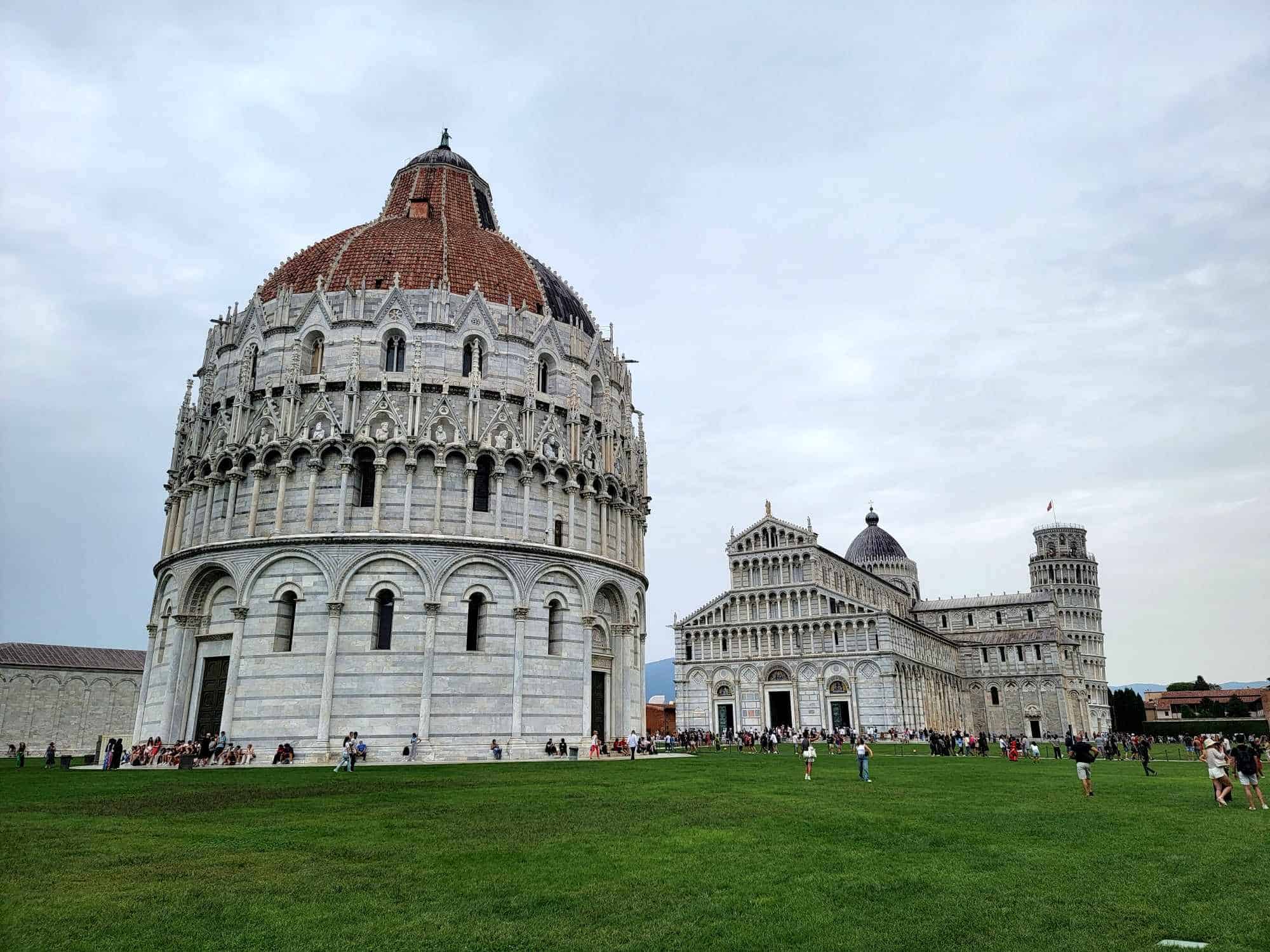Are you deciding if it’s worth taking a day trip to Pisa from another destination like Florence or Siena, or if you should make a detour on your Italy itinerary to see the famous leaning tower? Is it all just touristy hype? And what else is there to see in Pisa, anyway? Is Pisa worth visiting? You’re about to find out!
Pisa – the Good and the Bad
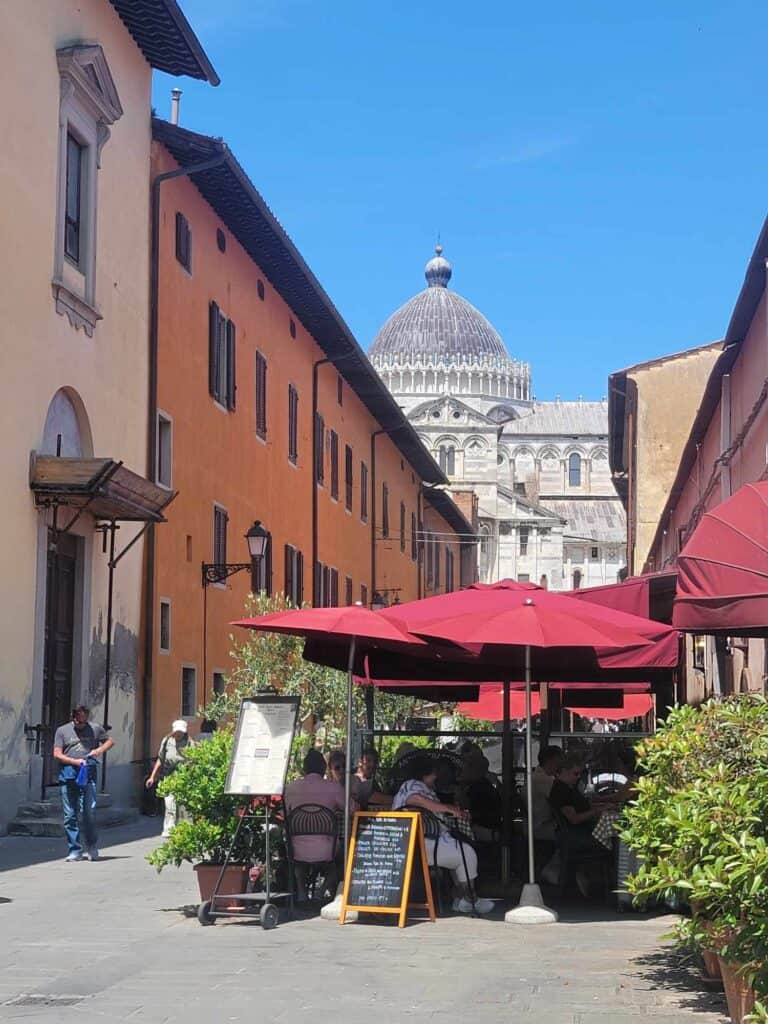
My first experience in Pisa was pretty awful to be honest. It was scorching hot, there were tons of people, we stopped there on a whim without being prepared, my dog was crazy stressed out, we were rushed, and I had the worst food I’ve eaten in the whole of Europe! But still, that experience kept nagging at me. What I did see near the tower intrigued me, and I wanted to give this famous city another chance, with a different approach. Boy am I glad I did! My second trip was a whole lot of fun, full of amazing sights, and one I will remember for a lifetime. So, is Pisa worth visiting? Yes, if you do it right!
Here’s how to have a great experience in Pisa!
When is the Best Time to Visit Pisa?
To avoid the crushing crowds in the most popular area of Pisa, try to avoid the months of June – September. It can also be very hot in those months. If you must travel during that time, then try to plan your activities either earlier in the morning, or late in the afternoon with strategic stops either in museums during the heat of the day, or to rehydrate and grab a bite when you need it.
Our first trip was mid-September, and the re-do was the end of May. The second trip was much better in terms of temperature, crowds, and general mayhem in the area near the tower.
How Long is Enough in Pisa?
Everything detailed in this post can be seen in one day, and will definitely hit the big highlights. To take things at a leisurely pace, add a nice dinner, and explore further, definitely add a second day. But like any Italian city, you’ll always wish you could stay longer!
Sponsored content: This section contains affiliate links powered by Travelpayouts
Piazza dei Miracoli (The Square of Miracles)
This is what everyone thinks of when they think of Pisa, and it’s where you should start. The “Square of Miracles,” a UNESCO world heritage site, contains much more than just the famous Leaning Tower of Pisa! You may have seen lots of pictures of the tower, and everyone’s obligatory Instagram shot, looking like they are holding it up to keep it from falling over, but the tower is only one feature of this truly amazing place.
Here are all the components of the Square of Miracles! But first some tips to make the most out of your visit.
Do’s and Don’ts
☀️ Do wear sunscreen – There are very few shady places to sit.
😎 Do wear sunglasses – The sunlight off the white marble is a thing and can cause some major discomfort!
💳 Do get your tickets ahead of time so you don’t have to wait in line, and so you make sure you can climb the tower if you want to. Don’t get timed tickets for the second you plan to arrive. Give yourself a cushion of time in case something goes wrong.
👟 Do wear very comfortable flat shoes!
🐕 Don’t bring your dog – I mean, you can, but it will definitely keep you from fully enjoying the experience since dogs are not allowed in any of these venues. There were lots of dogs out on the lawn, and lounging around in cafés but not in the museums or other buildings.
☠️ Don’t eat at the grab & go food stands across the street from the tower! So, so bad. Really.
🪙 Don’t forget to bring Euro coins for the mandatory locker to hold your bags if you climb the tower. And it’s always a good idea to have a little pile of 1€ coins if you need them for a restroom.
🍰🍷 Do grab a bite at the café in the Opera del Duomo Museum – best view ever!
1) The Leaning Tower
The world-famous leaning tower is actually the cathedral’s bell tower (campanile) with seven bells at the top! Construction began in the year 1173, and just a few years later it started to lean. The ground under the tower is soft, and eventually the bell tower’s tilt reached a dangerous angle of more than 5.5 degrees!
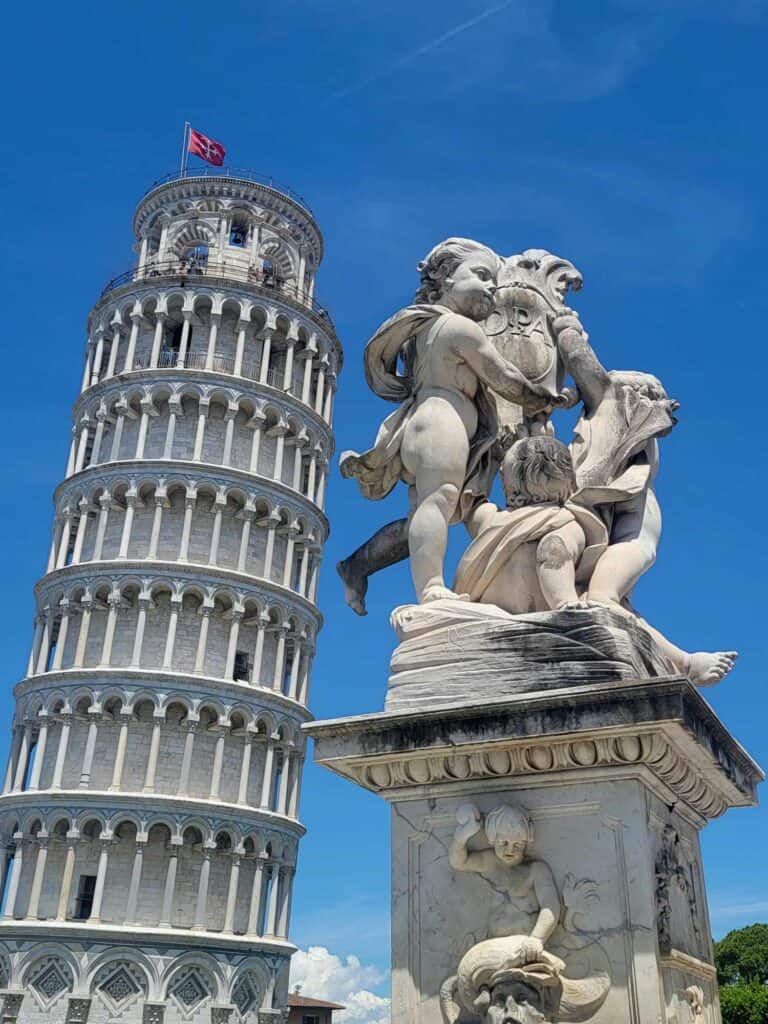
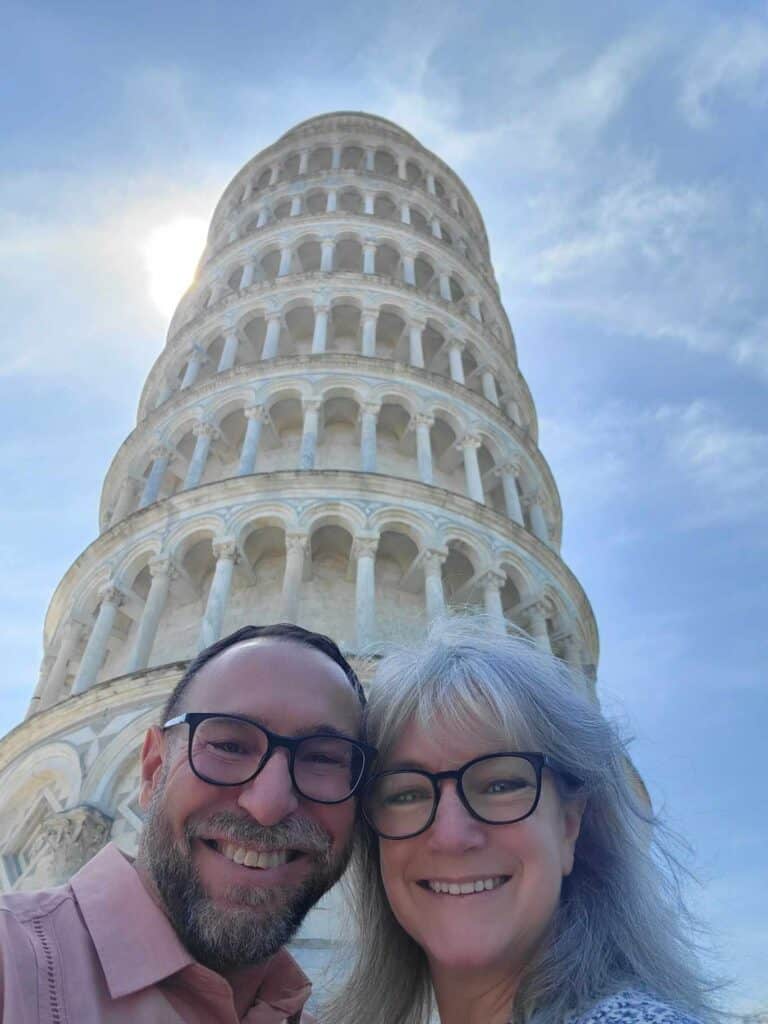
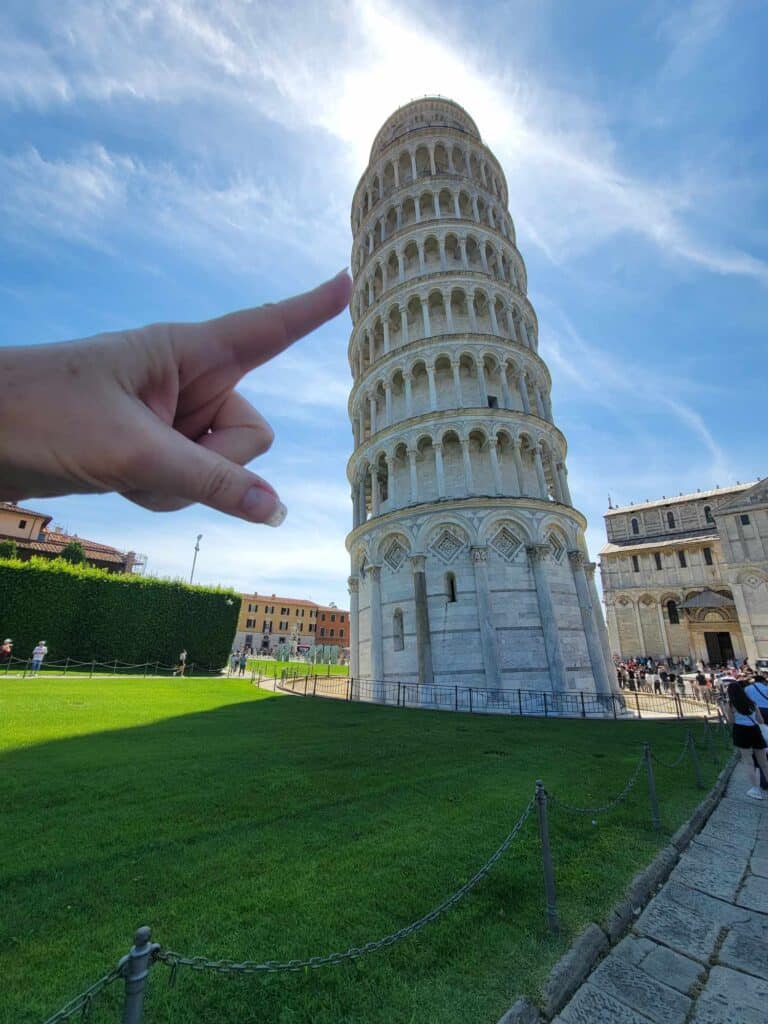
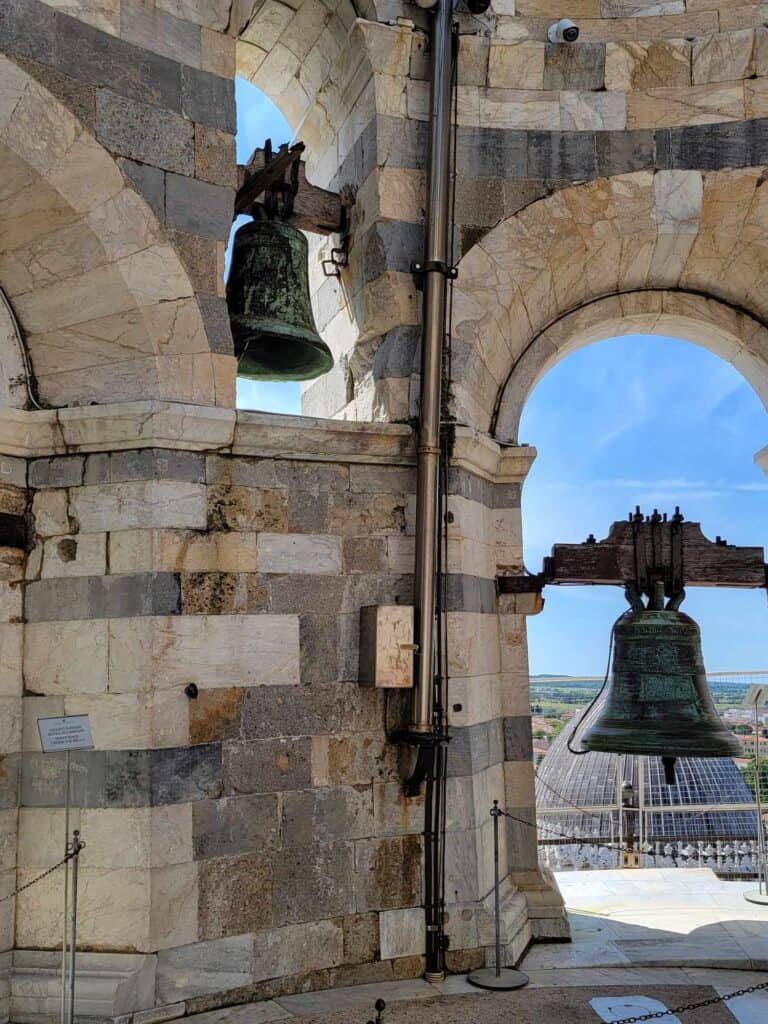
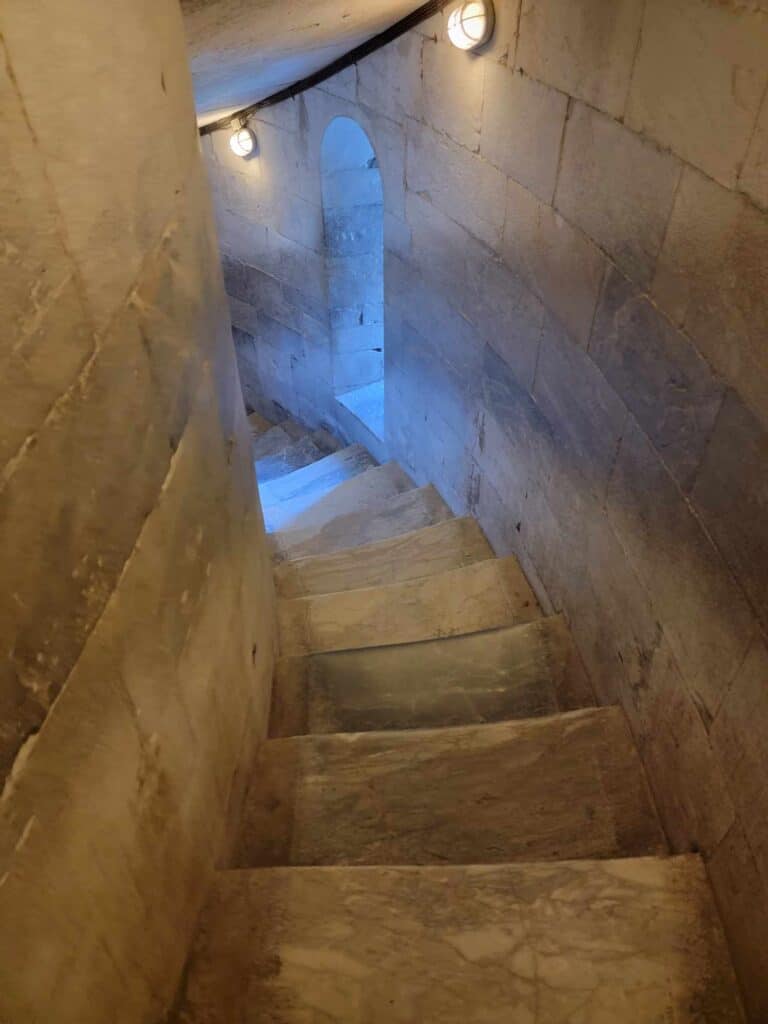
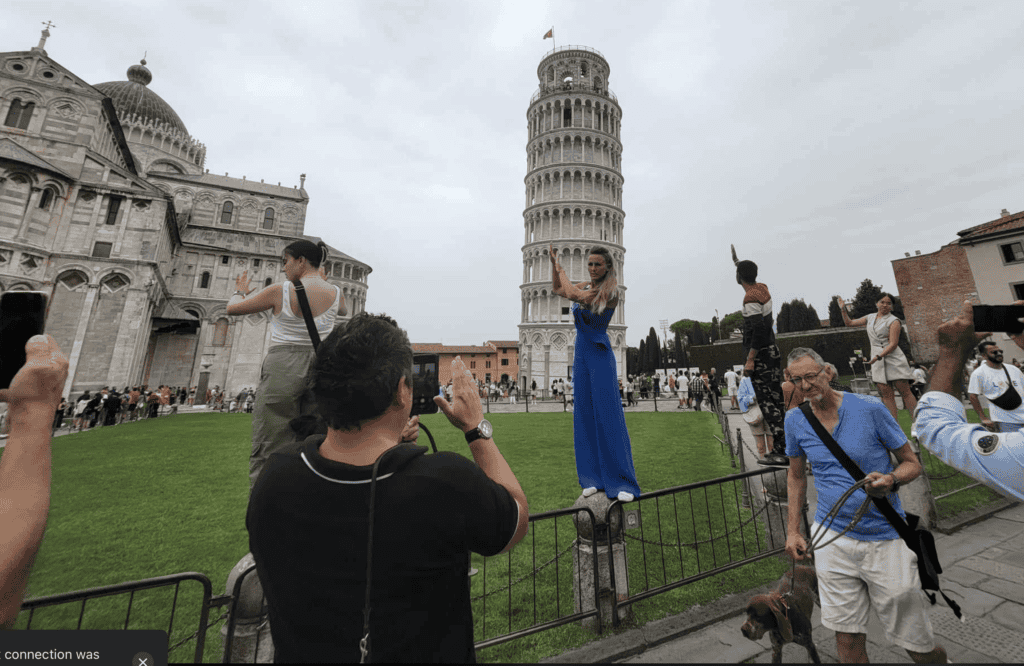
A huge and expensive effort was made to stabilize the tower so it didn’t collapse, and it was totally closed from 1990 to 2001 while almost 70 metric tons of dirt was removed from underneath the high side of the tower. The successful effort made the tower’s lean only 3.79 degrees.
They didn’t want to make it totally straight because where’s the fun in that, right? Engineers say the tower will remain stable for another 200 years, so you can now climb up and experience the gorgeous views, and the unique experience!
The Leaning Tower Experience
- ⏰ Timed tickets are required, and you can and should absolutely reserve your tickets ahead of time online. Plan to be at the complex well before your time slot, and check out the other things to see. If you are late for your time slot, you will have to rebook, and will likely miss out. They limit access to control the number of people in the tower at any one time. That’s probably a good idea! Once inside you can stay as long as you like.
- 👜You will need to store your bags (even small ones) in a locker across the square to be allowed in. You will need a 1€ coin to open the locker, and then you’ll get it back when you go to pick up your things. They are very strict with security, and also, you’ll be happy not to be lugging bags up the steps!
- 🪄You will also be wanded on your way into the tower.
- ⬆️ The climb is 296 steps from bottom to top. You’ll be able to feel the difference in the stairs when you are climbing on the uphill versus the downhill side. Also, notice how the stairs are worn differently on each side, and imagine how many feet have worn them down in 900 years!
- 🪟There are places on the way up where you can step to the side, catch your breath, and look out the windows to the spectacular view below.
- 🔔At the top, there is a narrow scenic walkway around the tower, and a section in the center where you can go and sit and look at the bells.
- ⚠️It’s a lot easier going down, but this is not an activity if you have bad knees, ankles, or stability challenges. The stairs are very uneven and narrow, and remember you’ll be climbing in a spiral that’s tilted by 4 degrees!
If you decide not to climb the tower, or if you can’t get tickets, you can still do the iconic leaning tower photo. And you won’t be alone! One of the funniest things to do in the Square of Miracles is just watch everybody posing for that shot. It’s hilarious! People watching at its absolute best!
Don’t forget to really take a look at the outside of the tower which is covered with beautiful marble inlay, and interesting sculptures. Leaning aside, it really is a spectacular work of architecture and art.
✅ Skip the ticket line, drop your bag, and go directly to the Leaning Tower!😊
2) The Cathedral (Duomo di Pisa)
The cathedral is the oldest structure in the Square of Miracles complex. Construction began in 1064, almost a thousand years ago! That same year, the reconstruction of Saint Mark’s Basilica in Venice began, which goes to show the rivalry between these two great maritime cities to see which one could create the most spectacular religious place of worship.
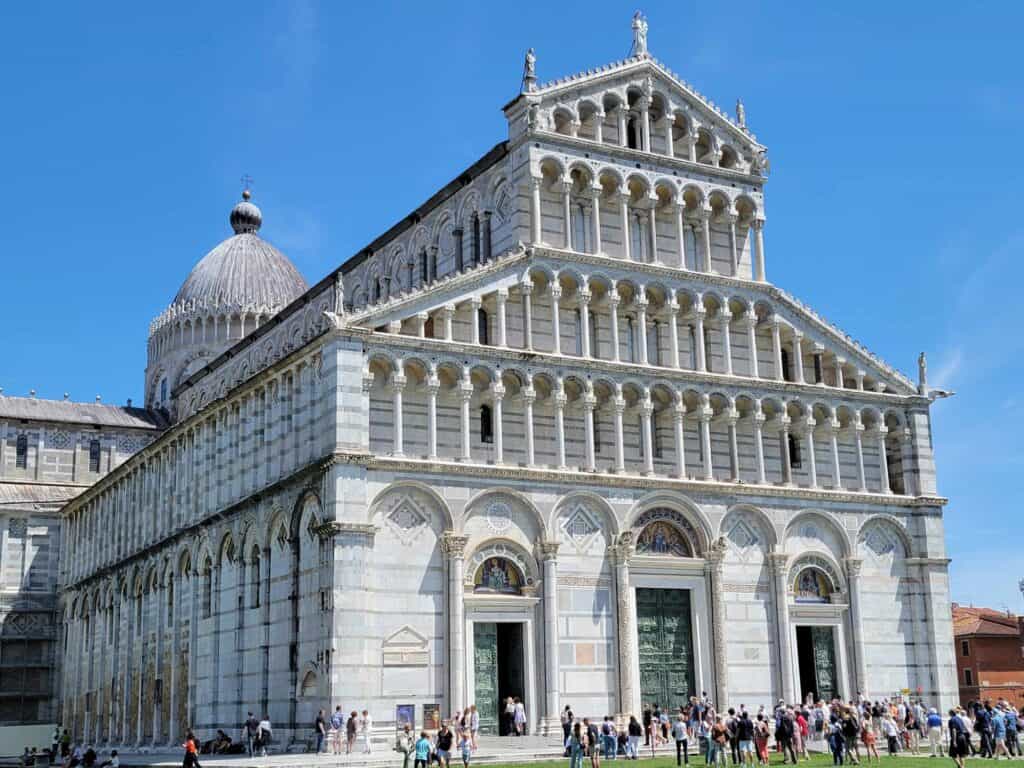
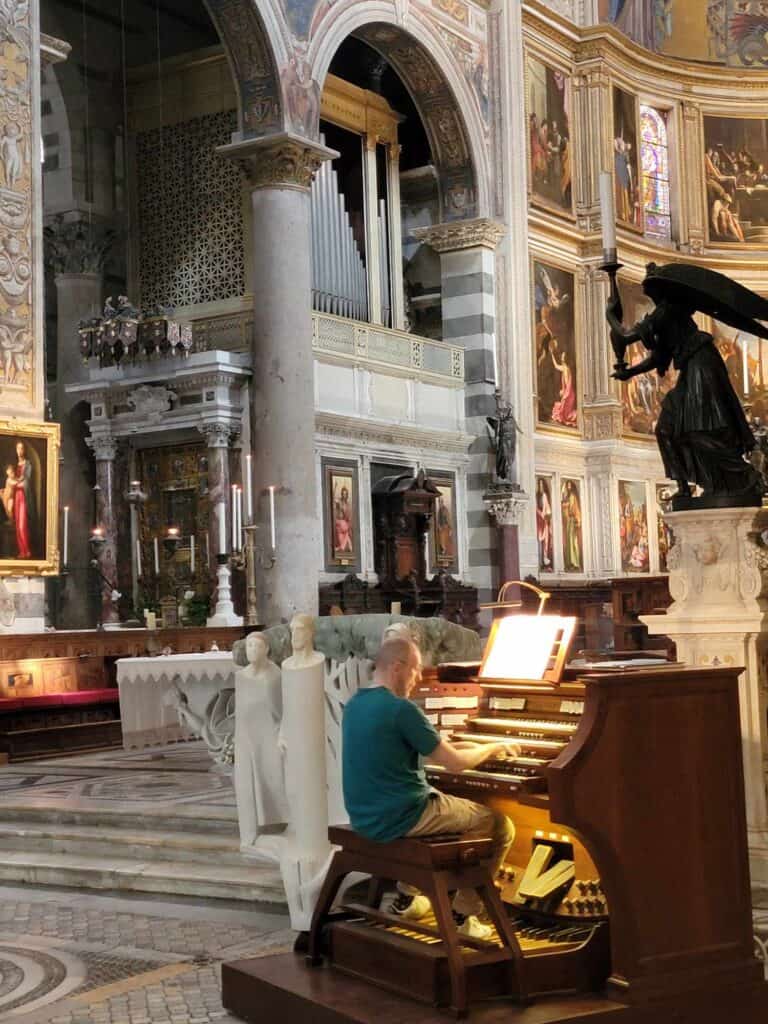
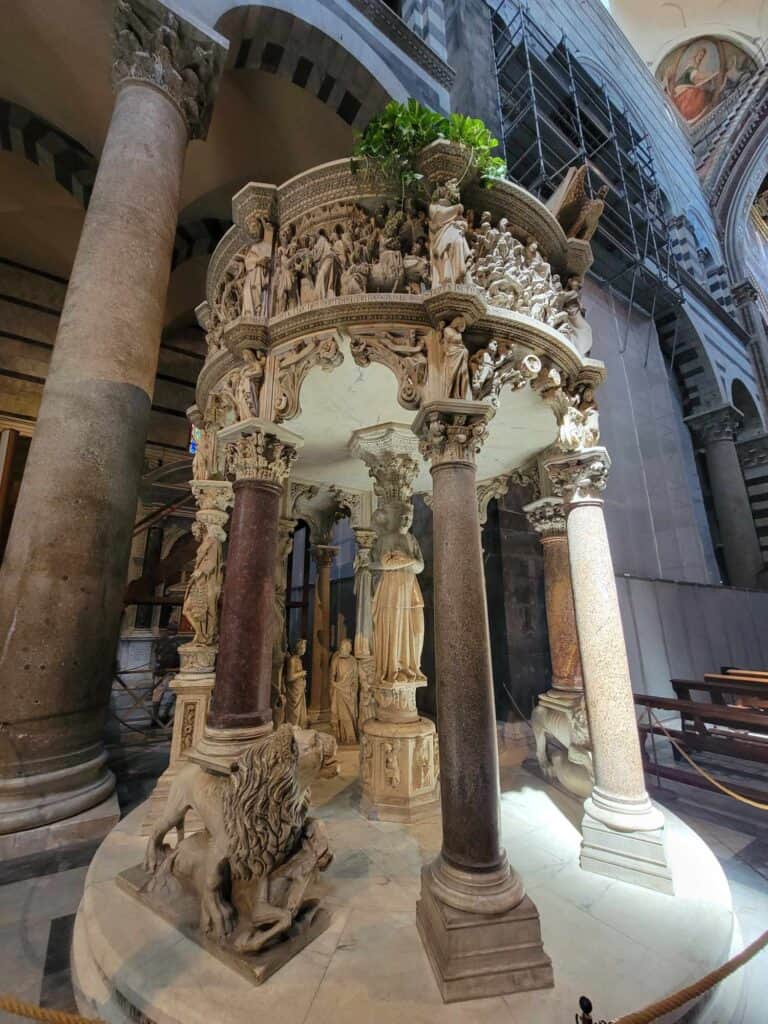
When you walk around the outside of the cathedral, see if you can find some of the reused building materials – massive blocks of white marble that were taken from Roman monuments to build the new structure.
On the inside is a feast for the eyes! You won’t be able to miss the incredible pulpit carved by Giovanni Pisano which survived a horrible fire in the cathedral in 1595. It is absolutely stunning and you’ll be amazed at the intricacy of the carvings which give the whole thing a feeling of lightness and movement.
You’ll also see the tomb of Henry VII, Holy Roman Emperor, and incredible paintings depicting stories of the Old and New Testaments created in the 16th and 17th centuries by notable Tuscan artists.
3) The Baptistry of San Giovanni
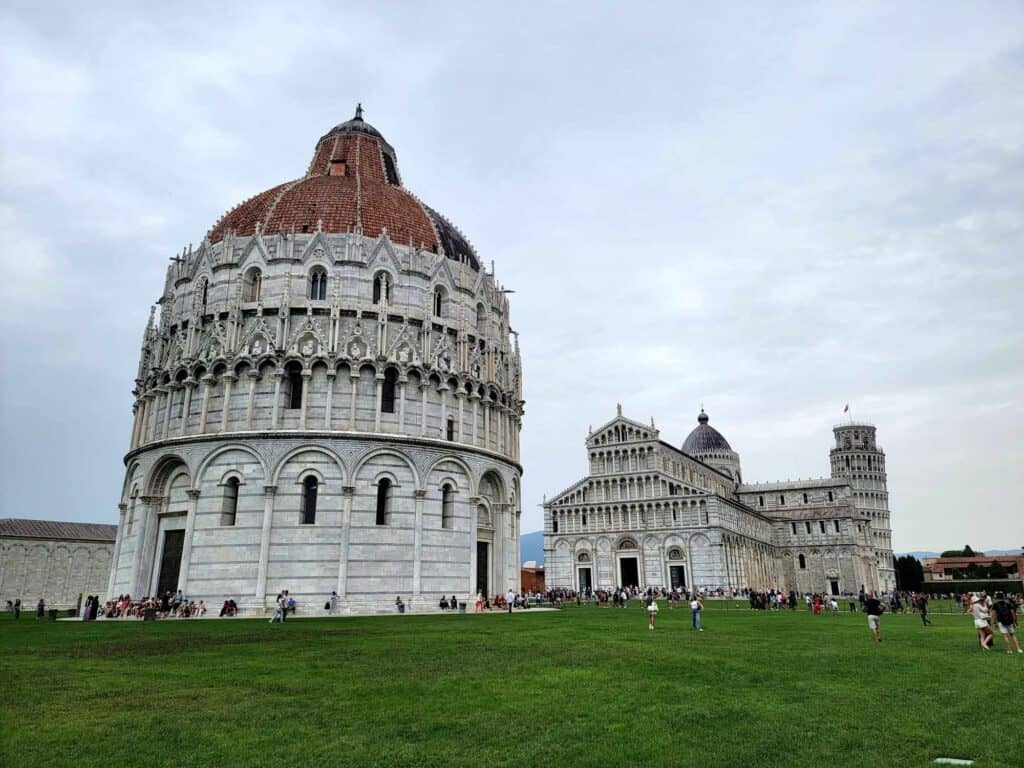
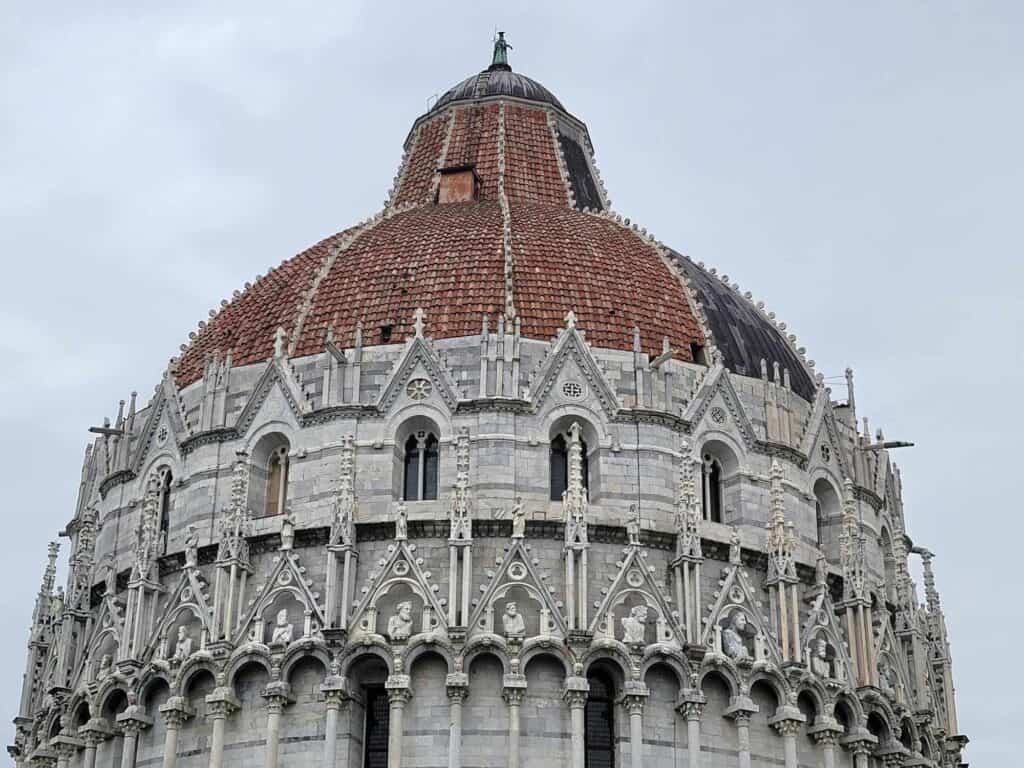
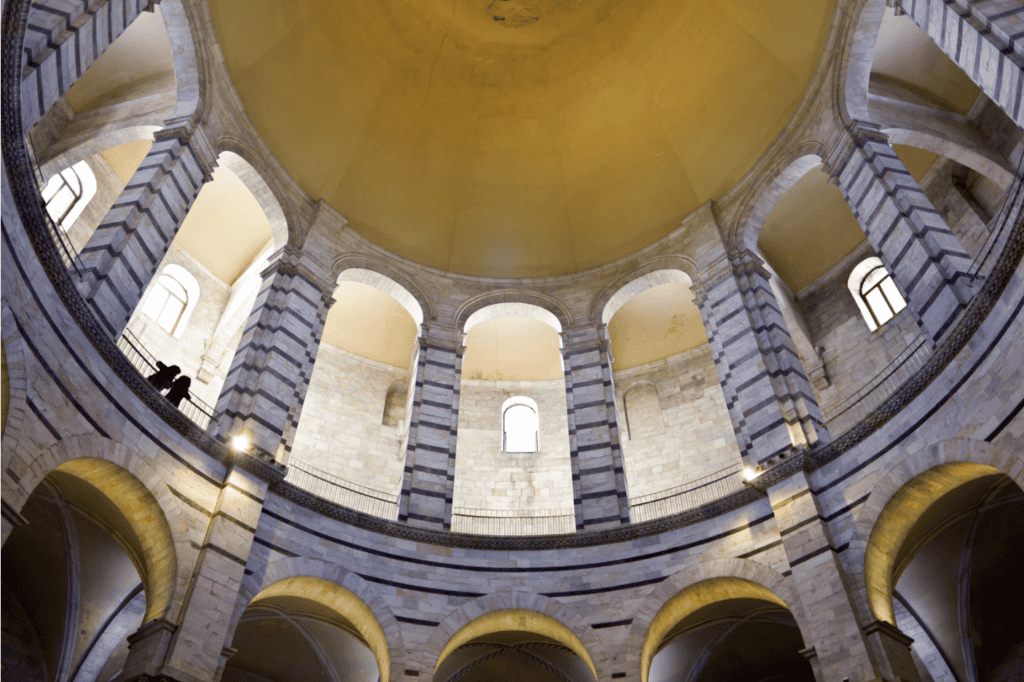
The Baptistry of San Giovanni is the largest baptistry in all of Italy and began functioning in 1152, baptizing both adults and children in its large baptistry font. The absolutely spectacular appearance of the baptistry makes it worthy of its neighbors, and it is a stunning achievement in its own right. Standing 180 feet tall, with walls 8 and a half feet thick, and the same incredible white marble facade as the cathedral and tower, it makes a powerful impression.
The vault of the baptistery is constructed with a double dome. This architectural feature gives the Baptistry remarkable acoustics, and when the building is open, every half hour an attendant will sing a few notes so you’ll be able to appreciate this unique feature of the building!
The Baptistry has undergone some restoration work recently, and ongoing renovations may affect hours of operation, or whether you’ll be able to see the entire thing. This link should keep you updated about hours of operation for the Baptistry.
4) The Camposanto
The Camposanto or Monumental Cemetery is the newest building in the complex, not finished until the mid 15th century. It served to gather the various graves scattered around the cathedral into one more dignified location, on the site of the former church which stood there before the cathedral was built. Legend says its construction began around a shipload of dirt brought to Pisa from Golgotha during the Third Crusade.
In the Aulla chapel you’ll see a rather unassuming incense lamp hanging from the ceiling. It is this very lamp (which used to be located in the cathedral) that inspired Galileo to his theory of pendular movements! There is no signage to this effect so don’t forget to seek it out!
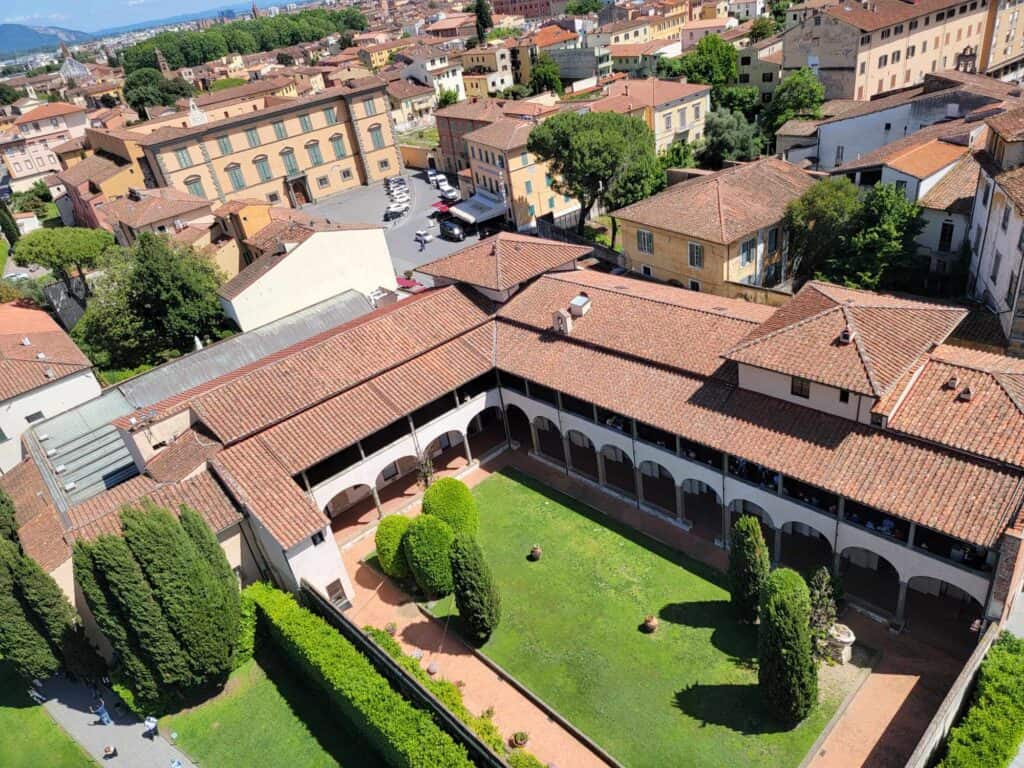
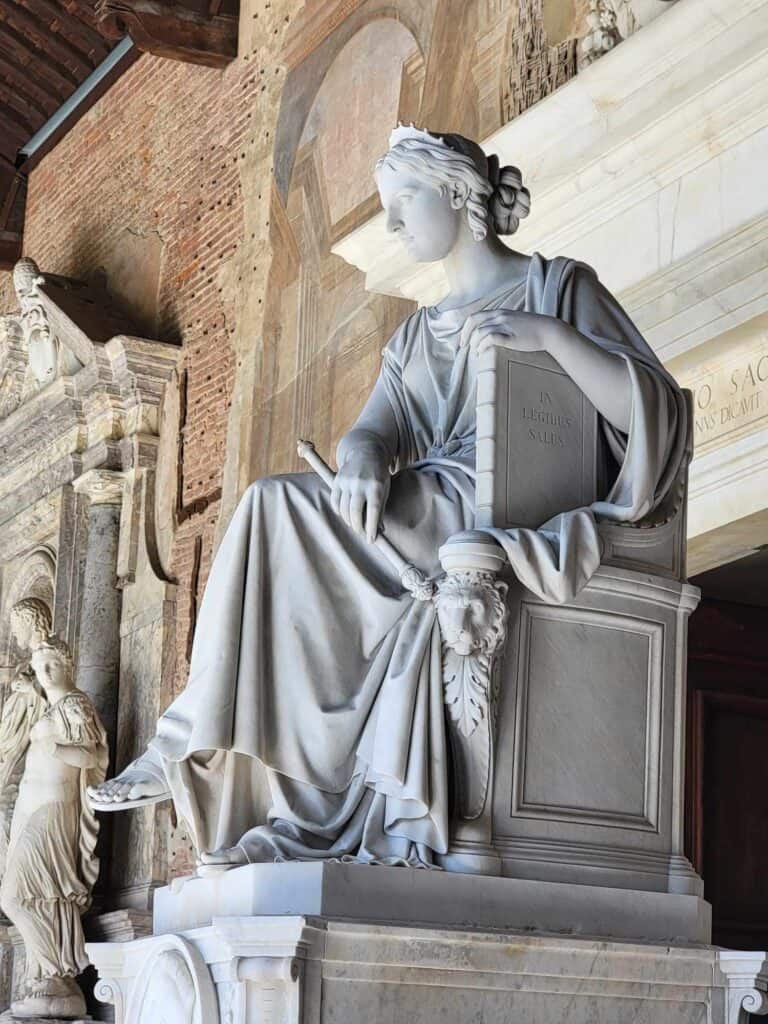
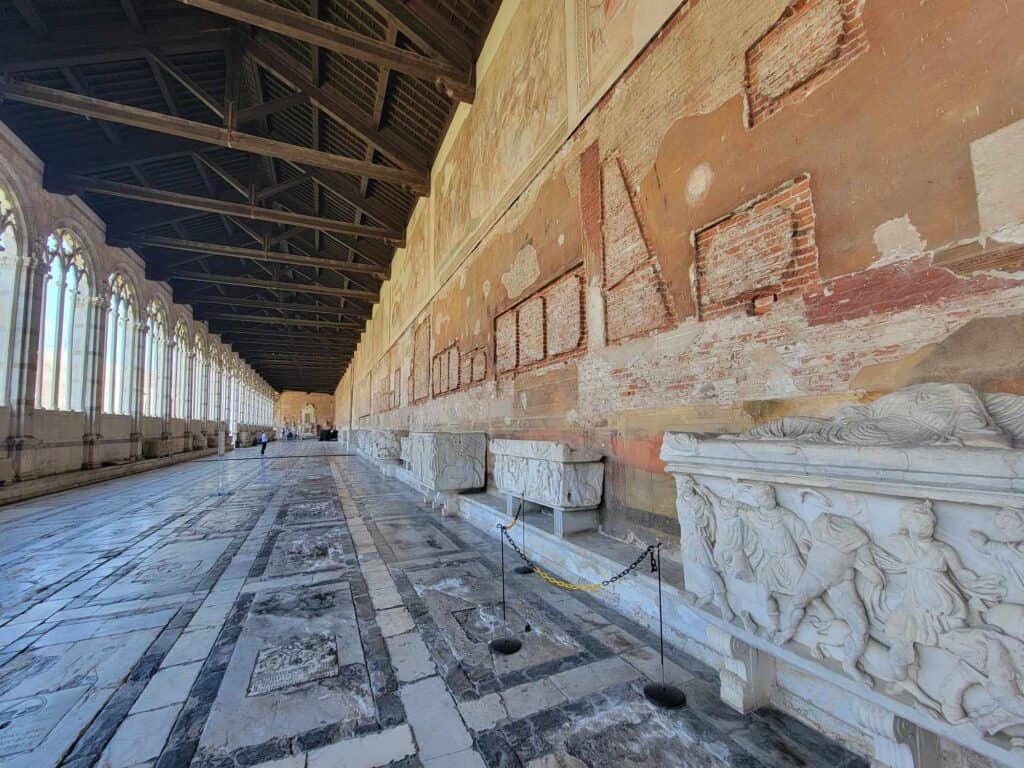
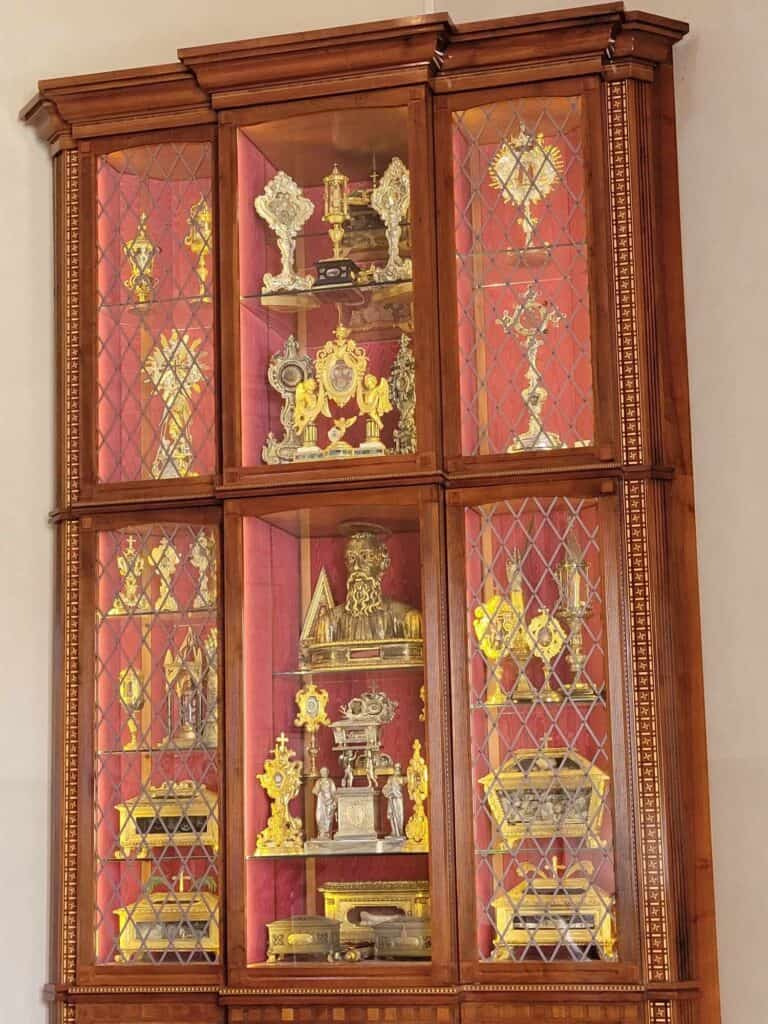
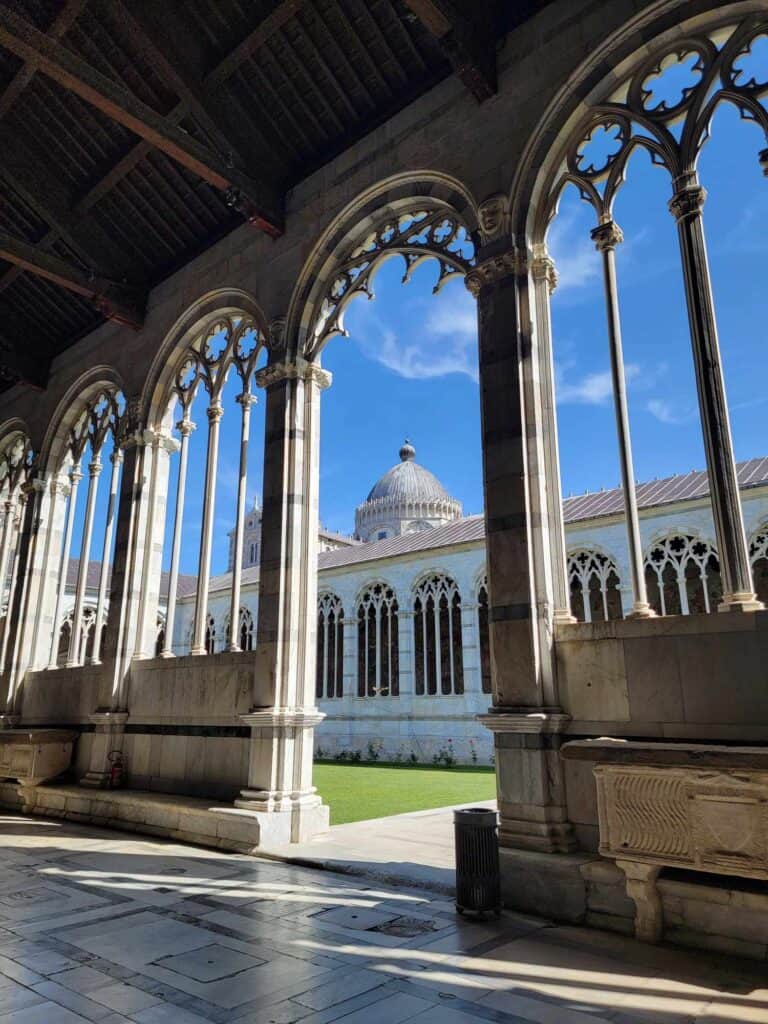
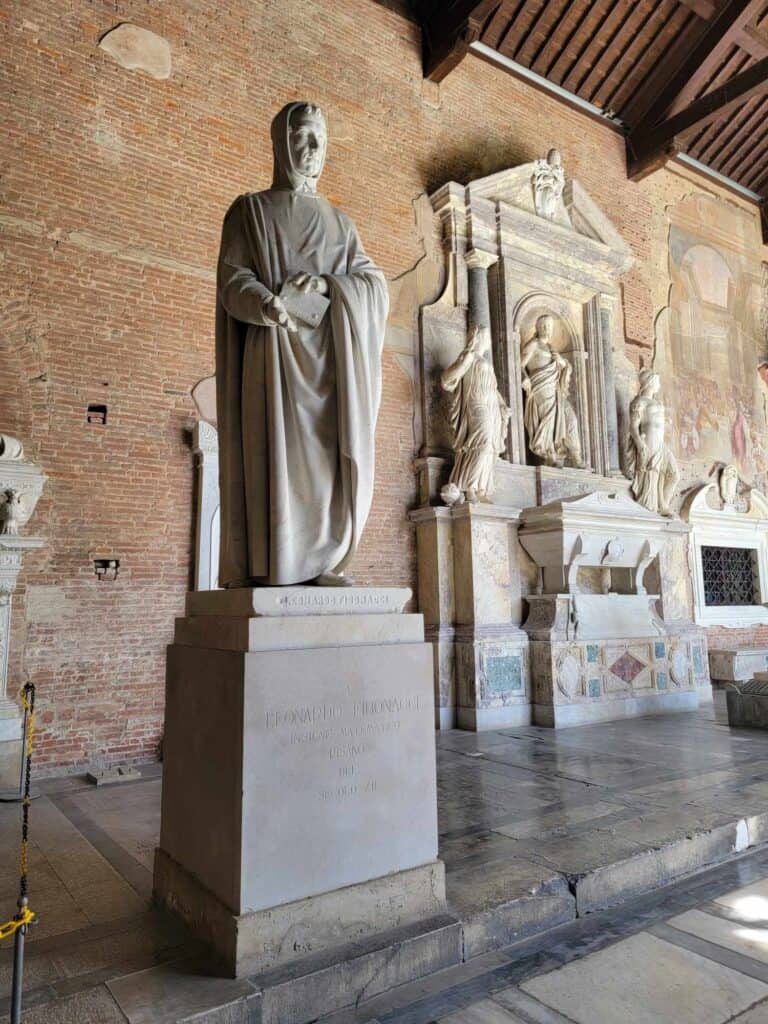
Math nerds will also be able to pay homage at the tomb of the famed Pisan mathematician, Fibonacci (Leonardo Bonacci), who was a professor at the University in Pisa and now rests in the Camposanto. The “Fibonacci sequence” is a series of integers that create many patterns found in nature.
The chapel of Del Pozzo from 1594 houses an astounding collection of relics from the cathedral perporting to be from 11 of the 12 apostles, a thorn from the crown of thorns, a small piece of the Virgin Mary’s dress, two pieces of the cross on which Jesus was crucified, and loads of others. There are small benches and a little dome in this chapel. There are also sign boards to help you figure out what’s where.
You can also see many fabulous Roman era stones and sarcophagi in the main passageway where you enter and exit.
5) Opera del Duomo Museum
Nope, it has nothing to do with opera! The Museo dell’Opera del Duomo (The Museum of the Works of the Cathedral) is located just next to the cathedral itself. It holds an impressive collection of artworks that are definitely worth seeing.
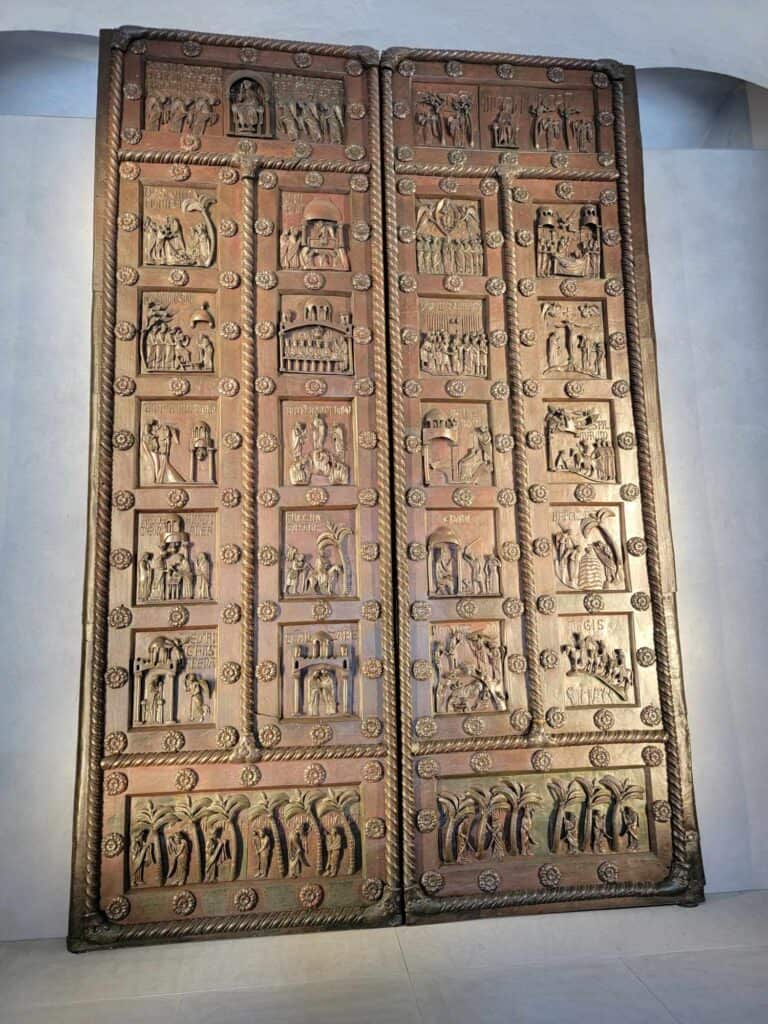
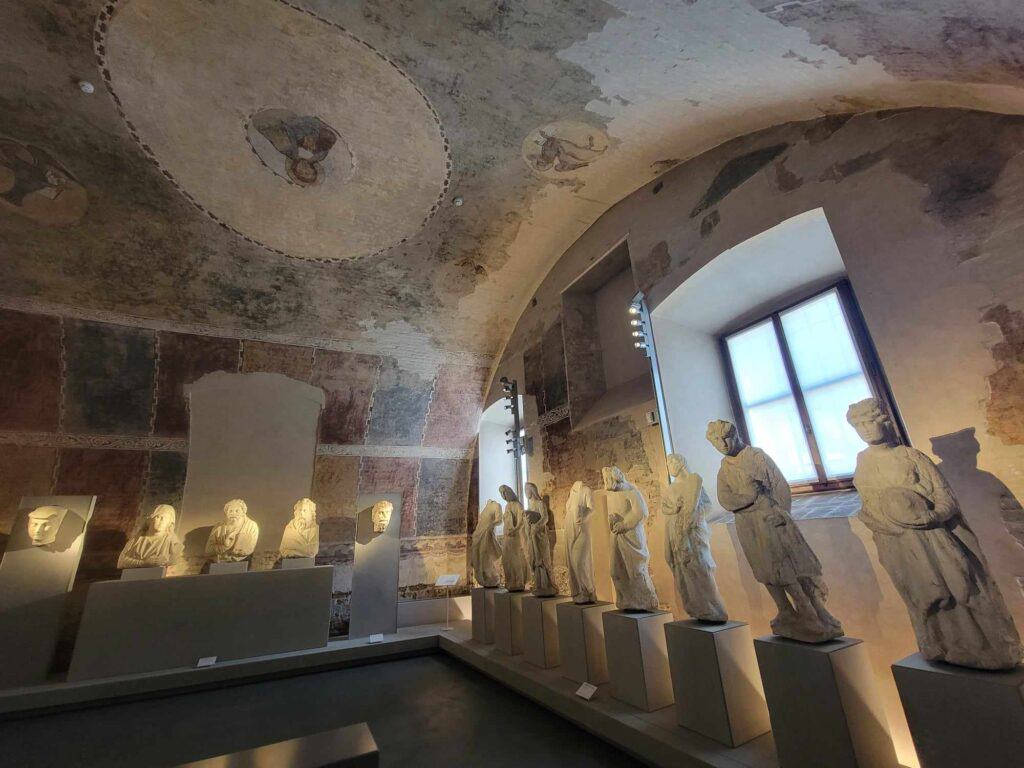
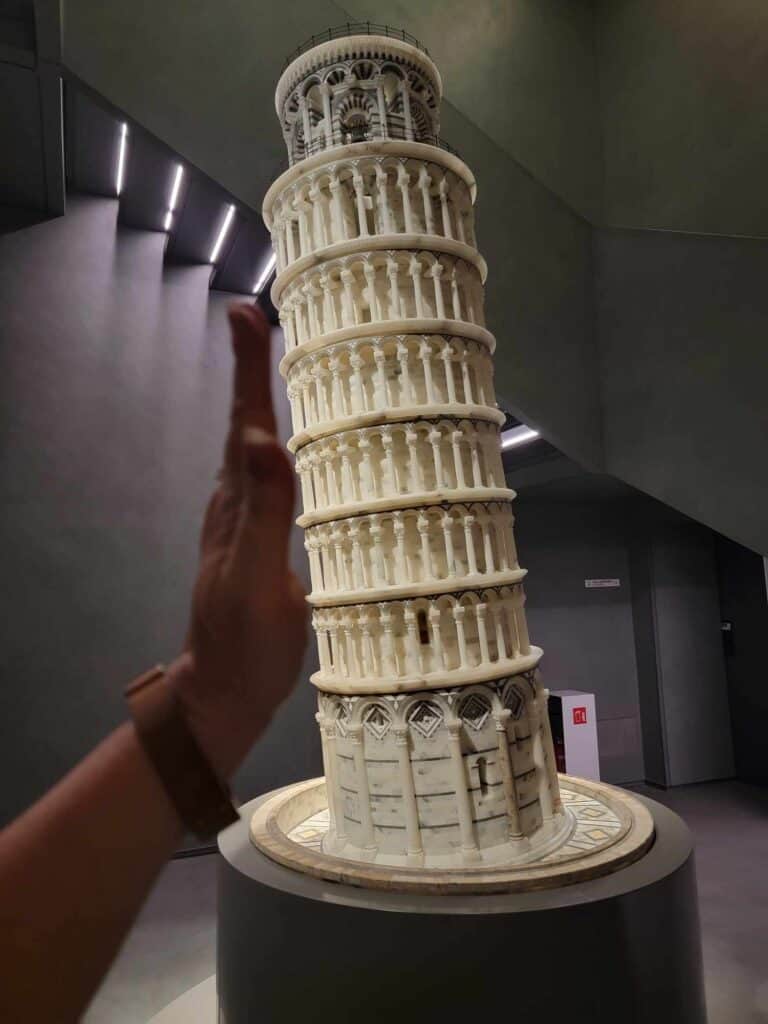
Often, important sculptures which were located outside on the edifice of cathedrals are brought inside to preserve them from the elements, and replaced with copies. In the museum you’ll be able to see lots of originals from the cathedral, including the unbelievable bronze doors.
If you still haven’t gotten your Leaning Tower fix, there’s also an impressive scale model of the tower.
And definitely do not miss the second floor! Not only is there a terrace that will give you an absolutely spectacular view of the tower, cathedral, and baptistry – you can eat there!

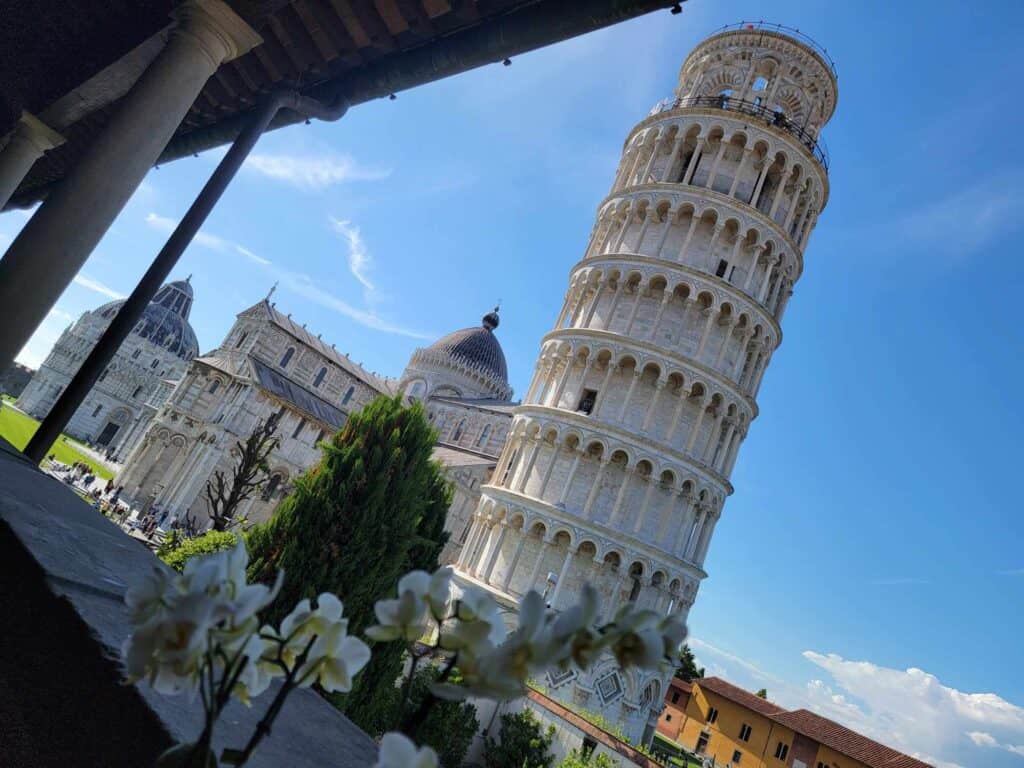
After a long day of museuming and climbing all those steps, we were happy to rest and enjoy the incredible view with a nice lunch. My pizza was scrumptious, and so was the pistachio gelato at the end. Definitely worth a stop!
Speaking of food… if you have time, Pisa is a fabulous place for a food tour!
Discover the local flavors and historical spots for the best food in Pisa with a fabulous guide! ⭐️⭐️⭐️⭐️⭐️ 🍝
6) The Sinopie Musem
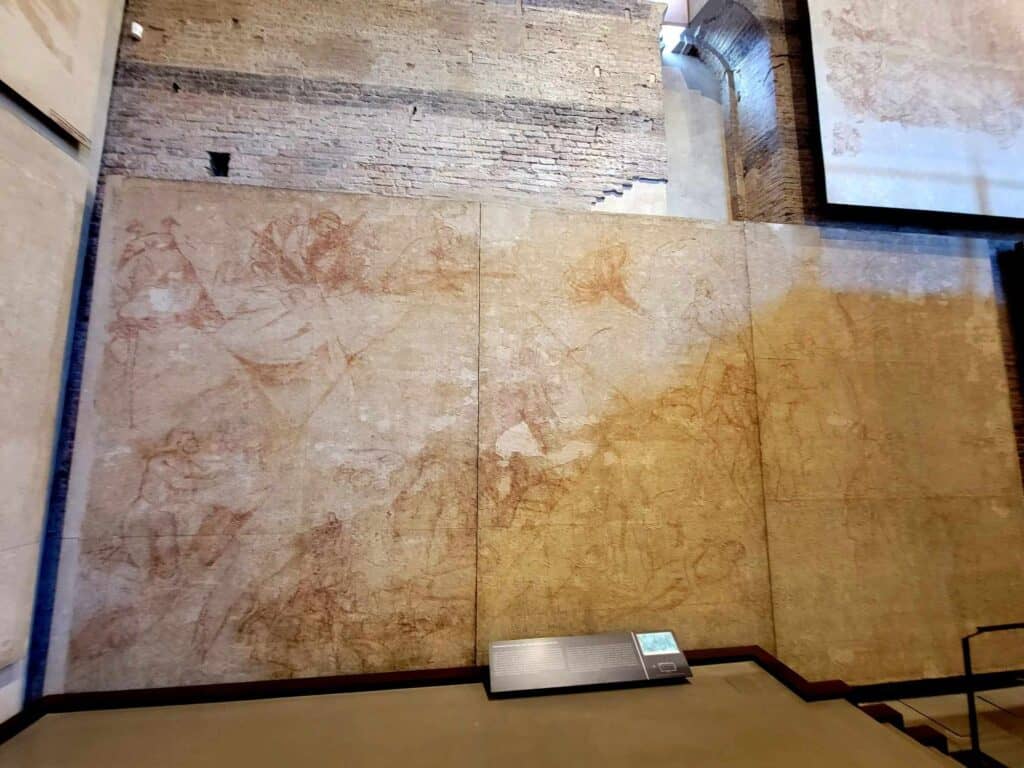
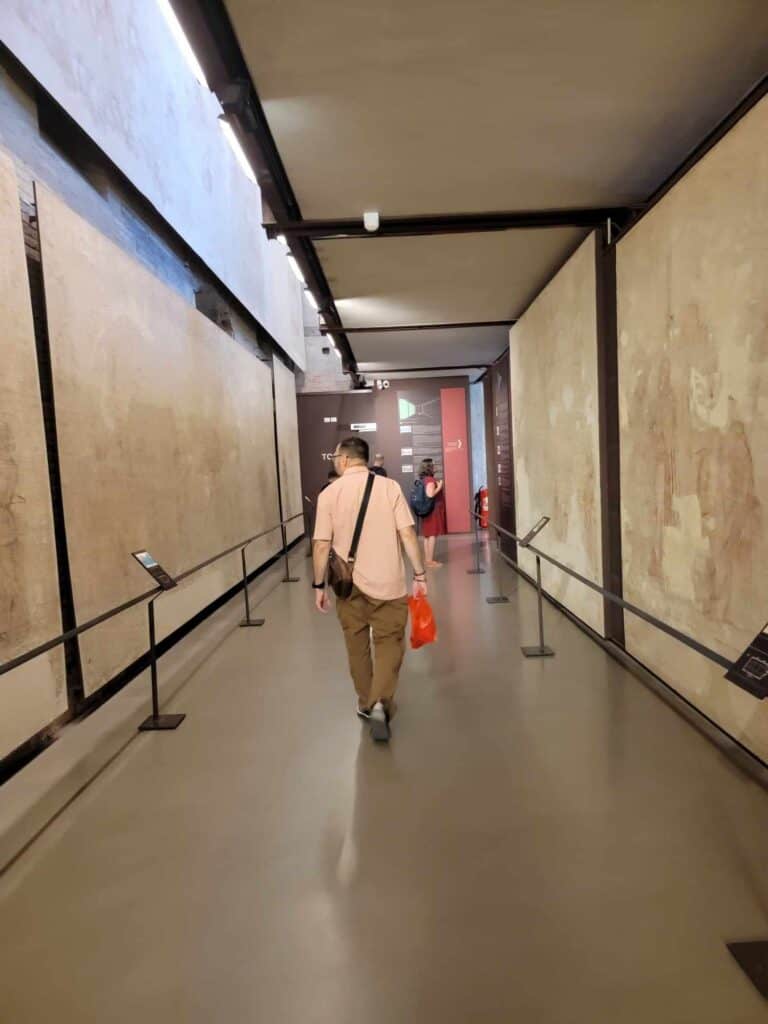
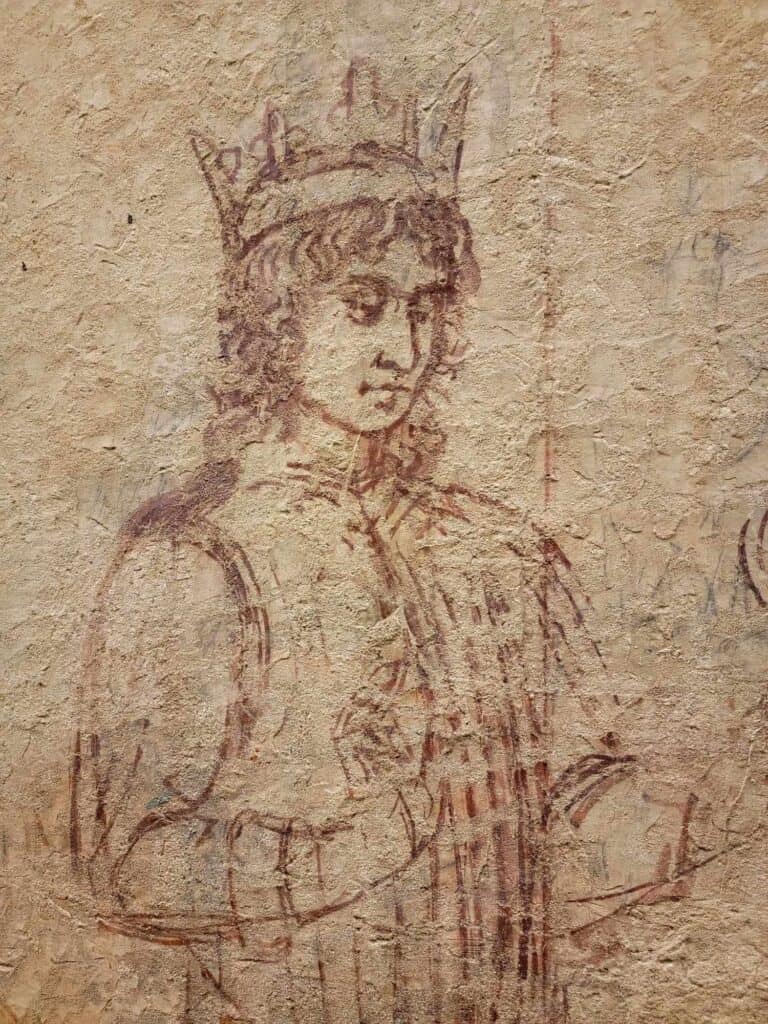
But wait, there’s more! One final museum will round out your visit to the Square of Miracles. This museum is both fascinating and tragic at the same time. When a monumental fresco is created, the first step is a brushed sketch or traced drawing applied to the first layer of plaster. This work is then covered over by the fresco itself and is never again seen. Or that’s the plan.
After a bombing raid during the Second World War, the Camposanto suffered severe damage (see below), and to save the remaining frescoes, they had to be detached from the walls, revealing those first outlines. Sinopia is the name of the red/ochre pigment which is mixed with water and used to paint the original image.
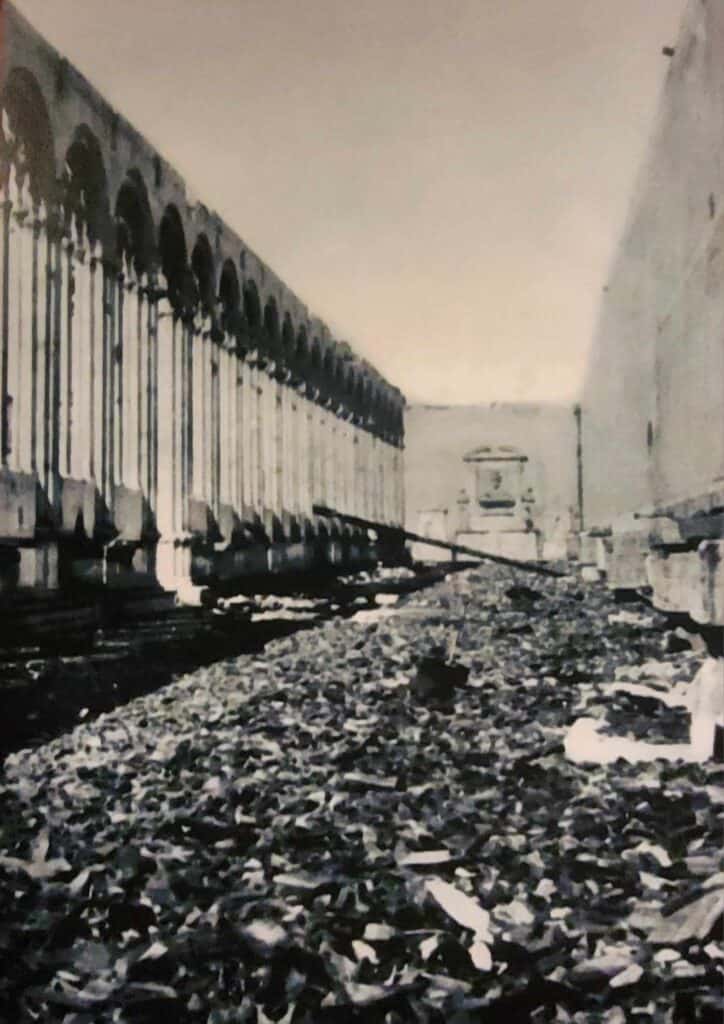
This museum is a quick visit, unless you are a real fresco aficionado, and this is how we ended our visit. It’s fascinating to see the hidden revealed, and compare what you see with the drawings of the original frescoes displayed next to each sinopie. And the massive size of some of the pieces makes you wonder what it must have taken to relocate it, even over a short distance. It is the only such window we have into this process, and worth a look.
🚻 Restrooms
No worries about finding restrooms at the Square of Miracles! There is a nice big clean restroom you can access right off the main lawn. It costs 1€ and there is an attendant who can make change. There are also free restrooms located in the Opera del Duomo Museum, and the Sinopie Museum.
Tickets
- Baptistry €7
- Camposanto €7
- Opera del Duomo Museum €7
- Sinopie Museum €7
- Leaning Tower €20
- Complete Visit without Leaning Tower €10
- Complete Visit plus Leaning Tower €27
The complete visit either with or without the Leaning Tower is definitely your best bet, even if you run out of time or miss one or two of the sites.
Tickets can be purchased online directly from the site beginning 90 days prior to your visit until the day of the visit, subject to availability. Here’s the link for everything you need to know about tickets.
You also may be able to get tickets from third party sites like Viator.
The Ancient Ships Museum (Le Navi Antiche di Pisa)
I loved this museum – a fabulous hidden gem! Just a quick walk from the Square of Miracles, it houses over 800 artifacts found at the old port of Pisa and surrounding area, all the way from pre-history through Roman times, plus the preserved wooden hulls of seven ancient ships! Apparently there were dozens upon dozens of ships found in the Arno River, but these seven were in good enough condition that they could be preserved and displayed.
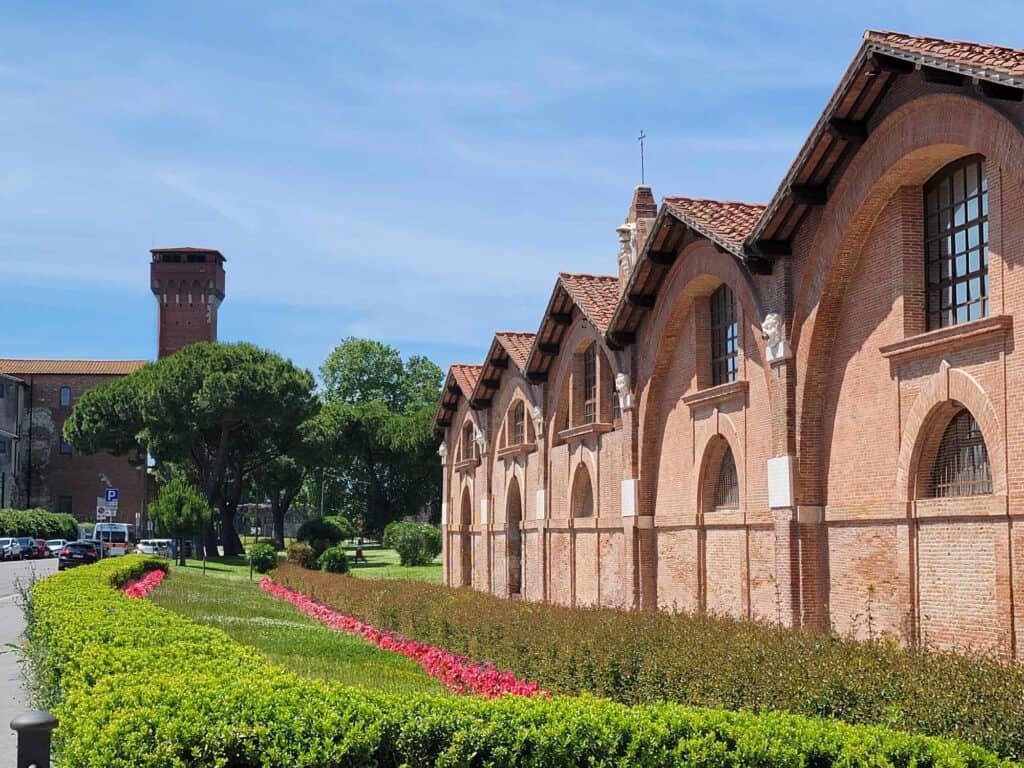
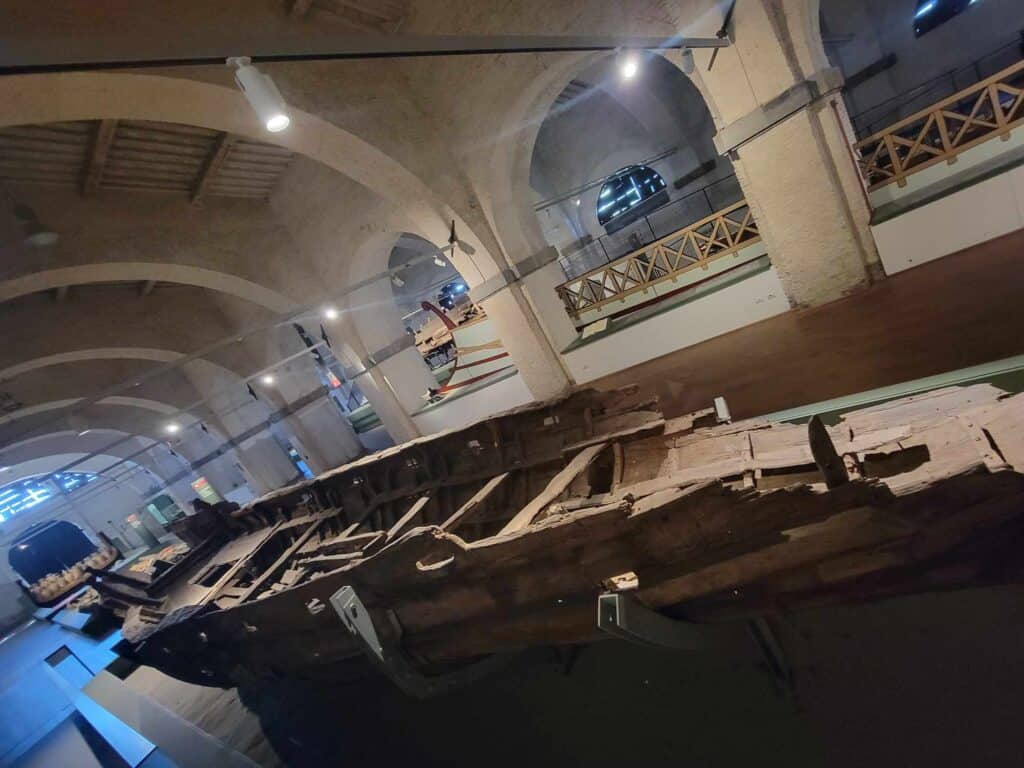
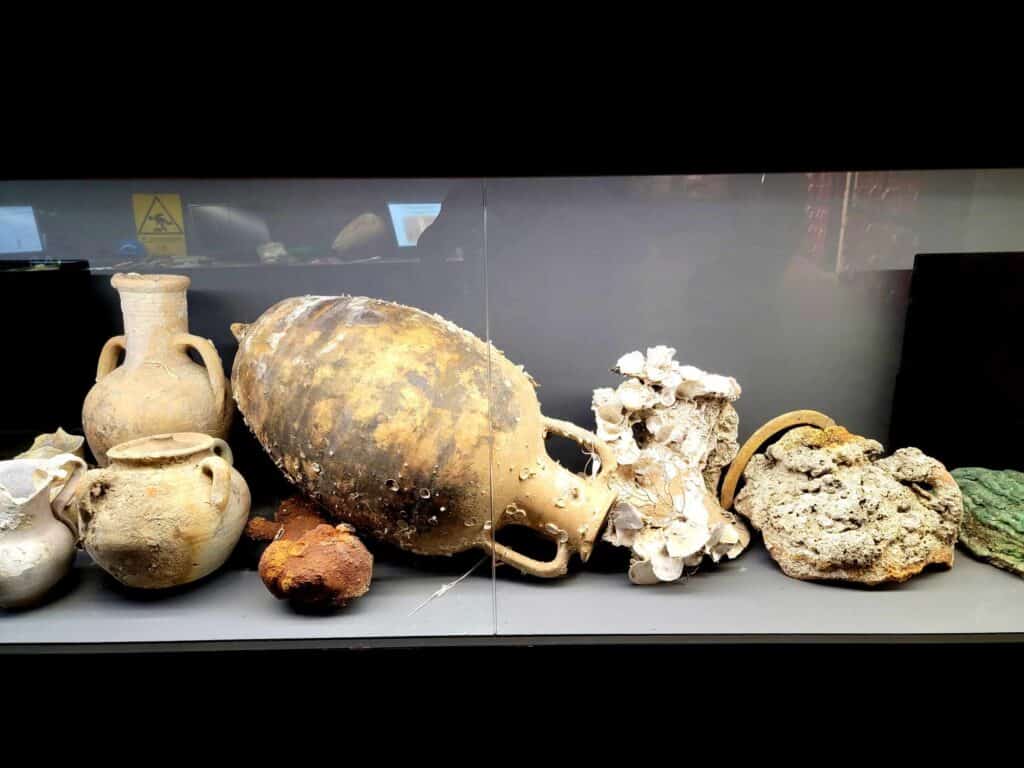
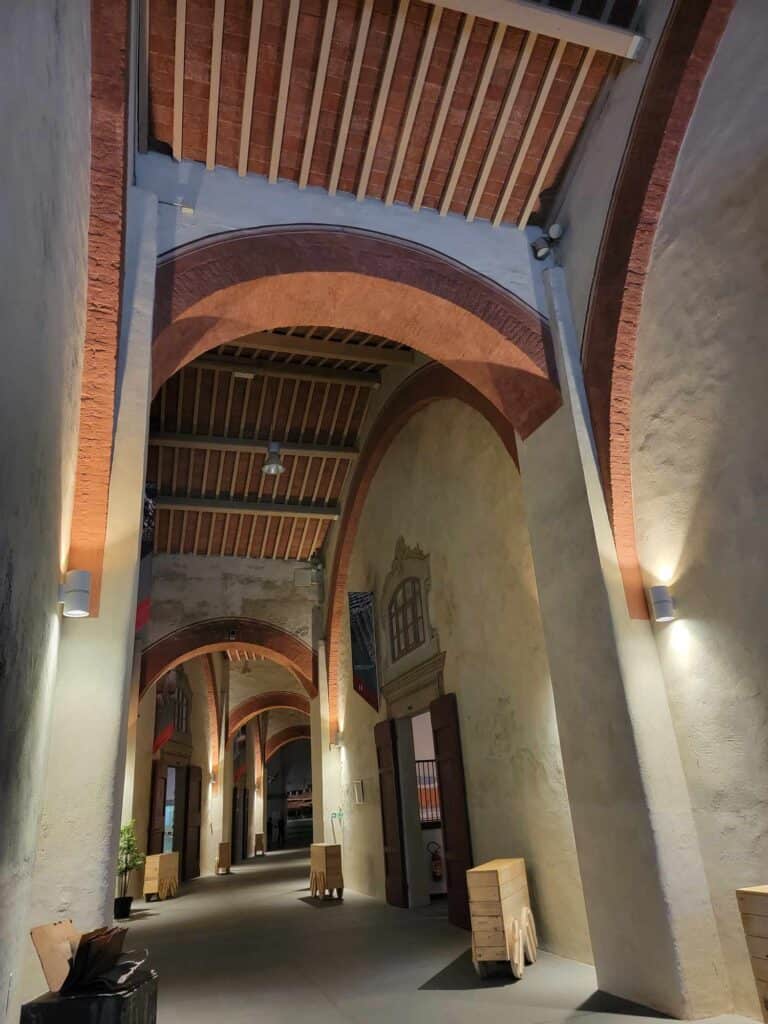
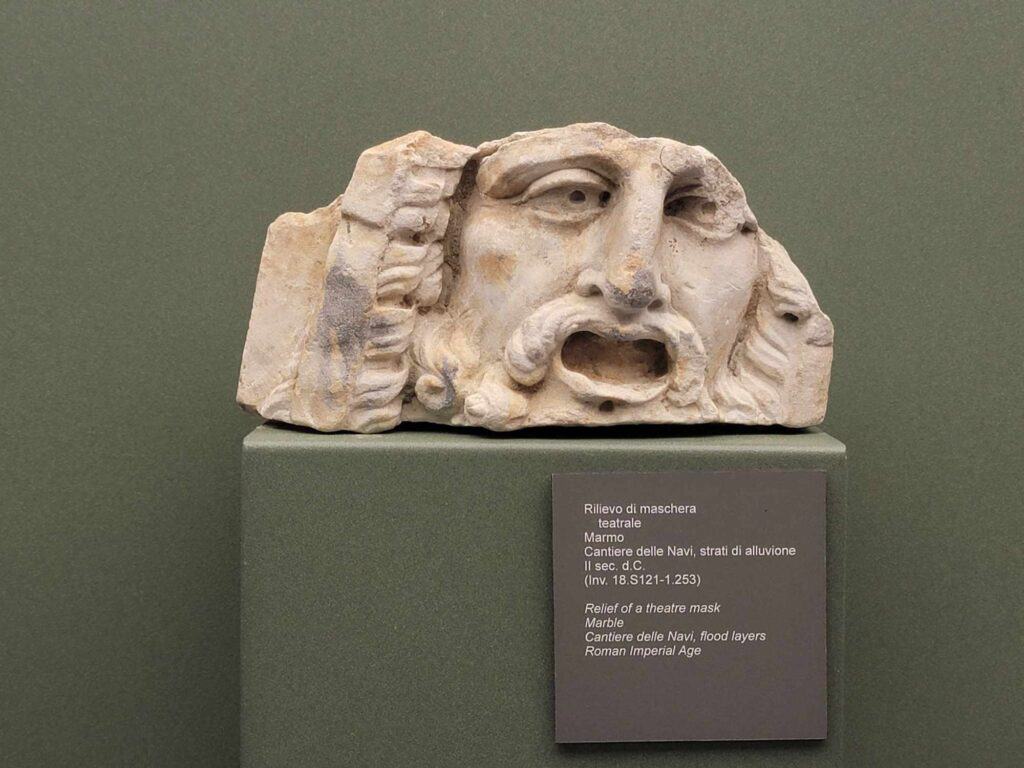
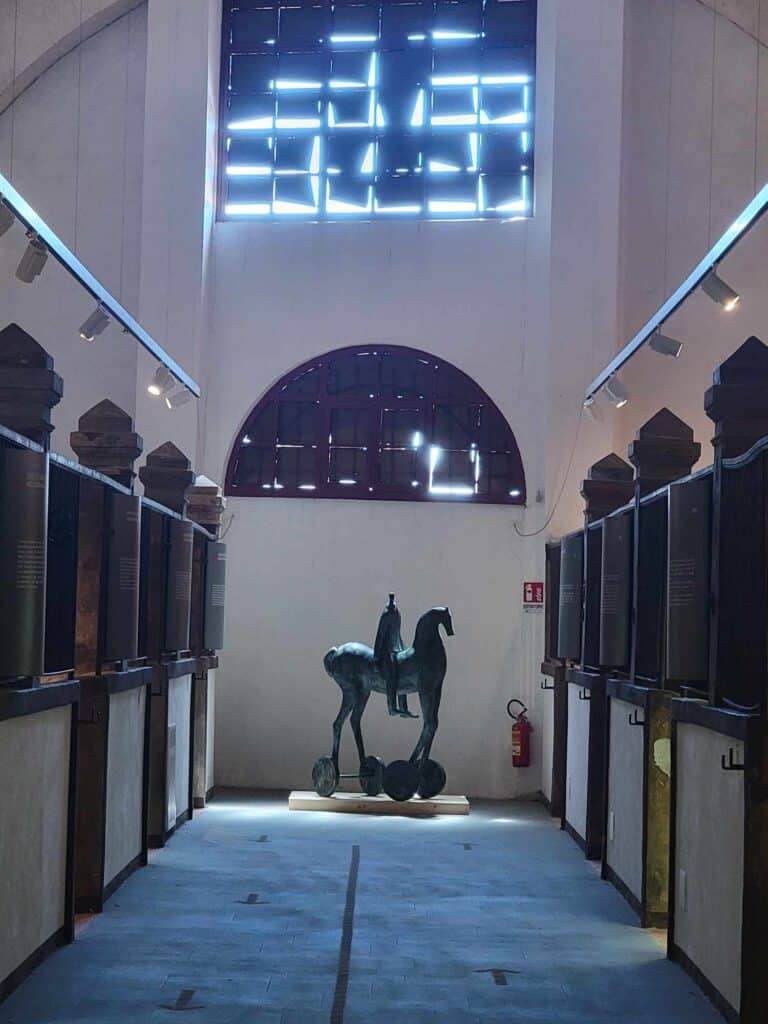
The fact that anything made of wood could survive so long is really incredible, but these ships are so well-preserved you can imagine them on the river, participating in the bustling life at the old port of Pisa. One even still has a deck!
This museum provided a really fascinating experience, and was so well curated. I could have spent even more time in there than we did.
🚻 There are free restrooms located in the museum, and lockers to hold your bags if you wish.
Caffè Martini (Piazza Solferino 14)
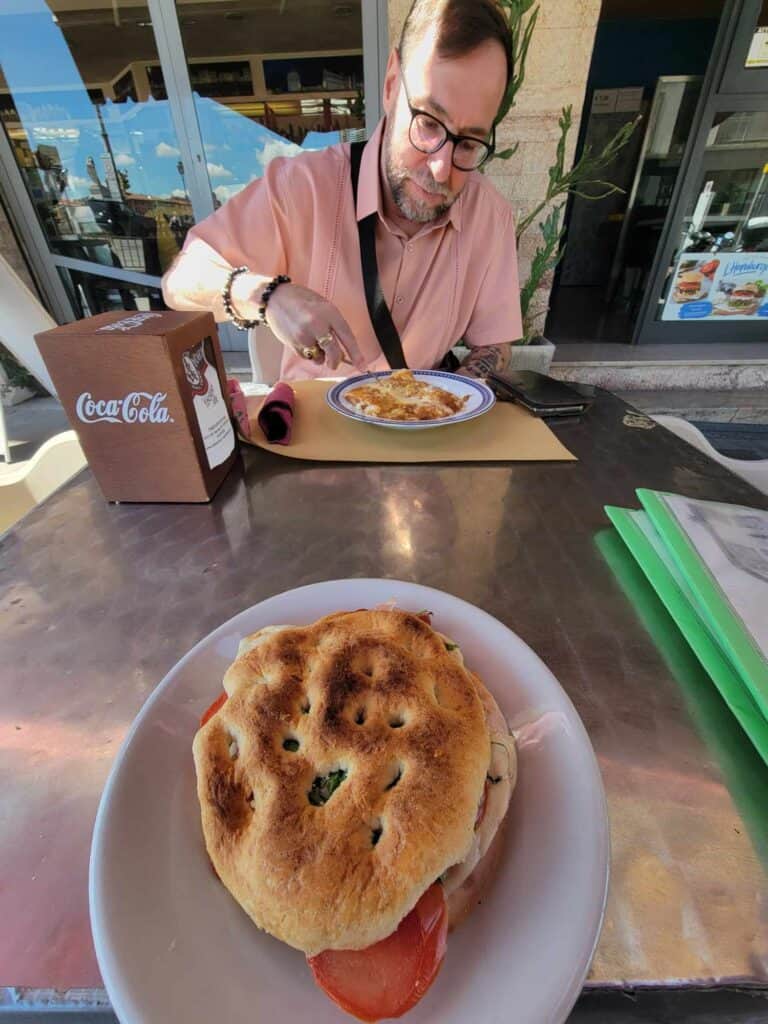
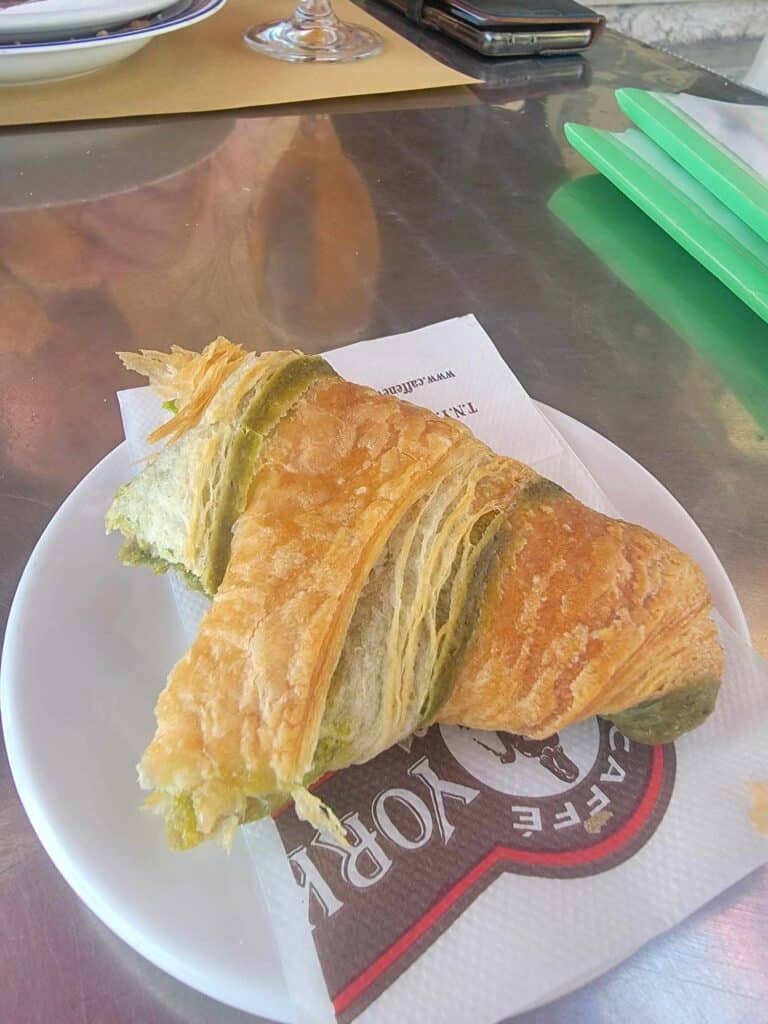
I would be remiss if I didn’t mention our quick bite at Caffè Martini, an unassuming little corner eatery between the Square of Miracles and the Ancient Ship Museum right by a beautiful bridge across the Arno River. Why? Because of the pistachio cornetto! Think of the crispiest, flakiest, most buttery croissant you’ve ever had, loaded with pistachio cream. Just the perfect amount of sweetness, and it tasted like it was baked by an angel on a cloud at the end of the rainbow. This may be my all-time favorite pastry on the planet. Shhh, don’t tell France!
I haven’t seen this one among the list of Pisa’s best caffès, and honestly you could easily walk right by it. It wasn’t vying for Instagram fame, but I’m telling you, I will be dreaming about that cornetto for the rest of my life.
Other Things to See in Pisa
The Square of Miracles and the Ancient Ship Museum make one perfect long day. But if you have more time, there are many other things to see in this historic walkable city. Here are some ideas!
Galileo’s Birthplace (Via Giusti 24/26)
Pisa is the birthplace of one of the greatest scientists who ever lived, and his house still stands! Because of course it does! Galileo Galilei was born in what is today an unassuming little pink house marked with a plaque. Sadly, the house is privately owned and not open to the public but it’s pretty incredible that it is still standing at all, so it’s worth a quick walk-by if you have time.
Botanical Garden (Luca Ghini 5, Pisa)
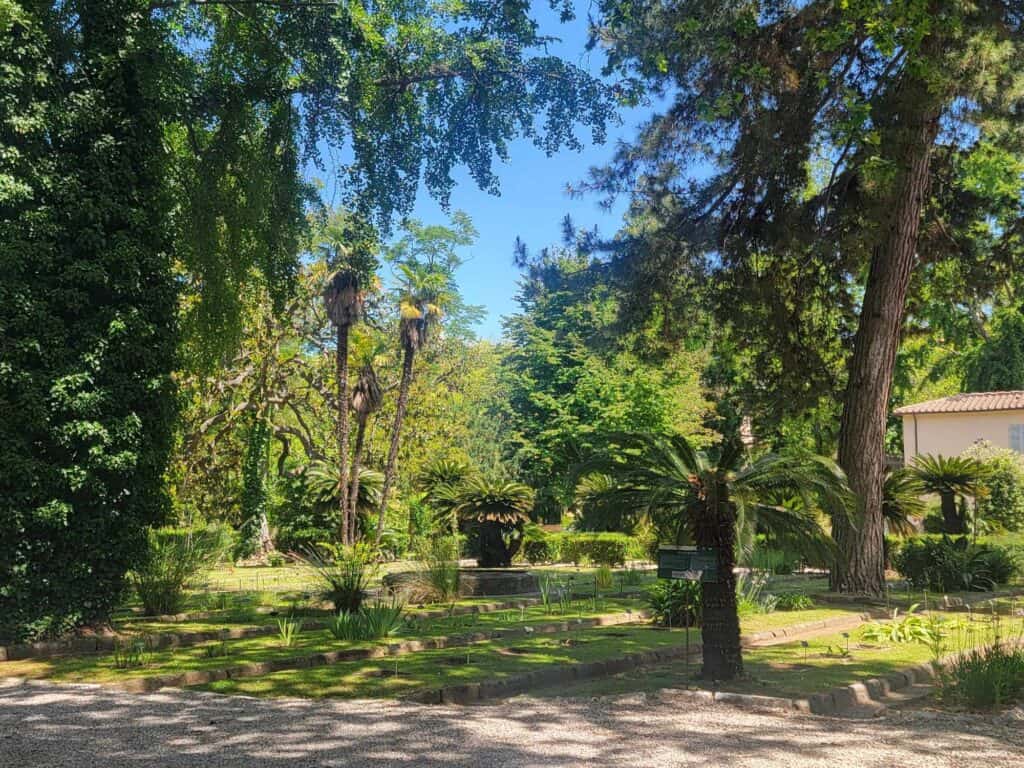
The Orto botanico di Pisa operated by the University of Pisa is no ordinary botanical garden! Founded in 1544 under Cosimo di Medici, it is the very first university botanical garden in Europe!
It includes a library, a gallery of natural objects, one of the earliest iron-framed greenhouses in Italy, and portraits of its directors over the centuries. Enjoy a walk through the greenery to see the herb gardens, flowers galore, and the old botanical institute which was built in the late 1500s with a facade decorated with sea shells!
This is also located on the way from the Square of Miracles to the Ancient Ship Museum.
Chiesa di Santa Maria della Spina
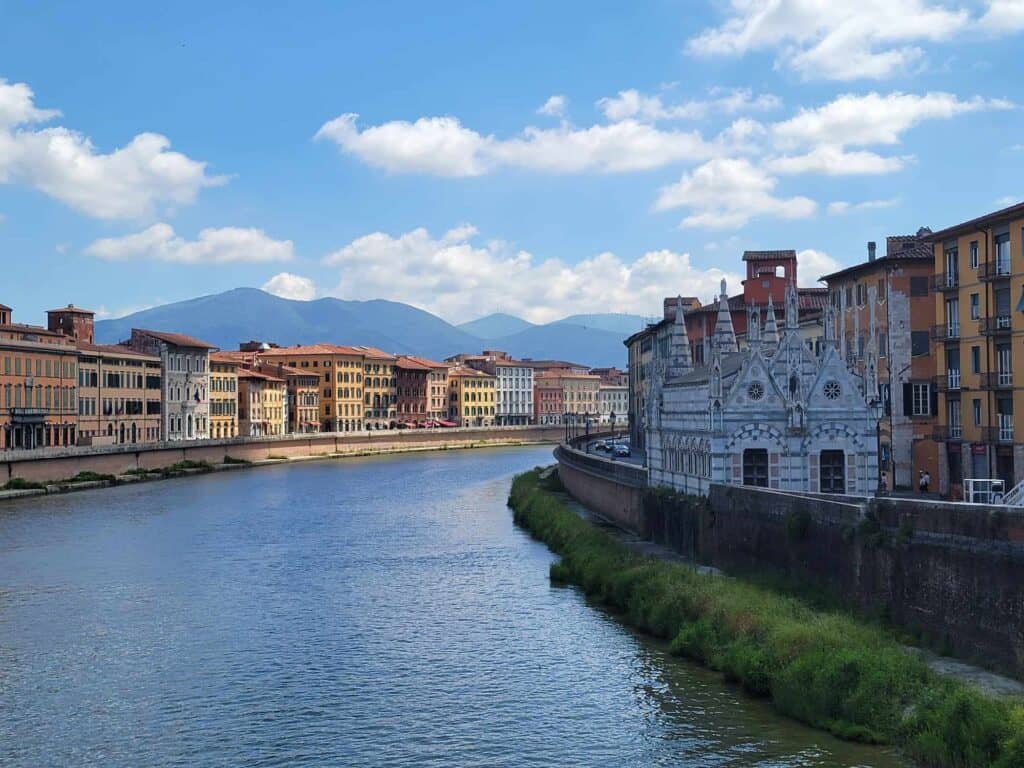
Located just on the left bank of the Arno River you’ll find a small but exquisite example of Gothic Pisan architecture. We parked right on the same street and when we got out of the car, we gasped. It really is stunning. Began in 1230, it has undergone several restorations, the latest in 1871. At that time it was completely dismantled, and raised to a higher location so it wouldn’t slough off into the river.
The name originates to 1333 when the little church was said to have housed a relic of a thorn from the crown of thorns – spina. That thorn is now on display in the church of Santa Chiara.
You may get lucky and find it open to visitors, but even if you only see it from the outside it really is a hidden gem and worth seeking out. It’s just across the river from the Ancient Ship Museum.
Museo Nazionale San Matteo (National Museum of San Matteo)
Housed in a former Benedictine monastery, the National Museum of San Matteo houses an impressive collection of Pisan and Tuscan art, from medieval sculptures to Renaissance paintings. Included are works by Ghirlandaio and Donatello!
Palazzo dei Cavalieri (Palace of the Knights)
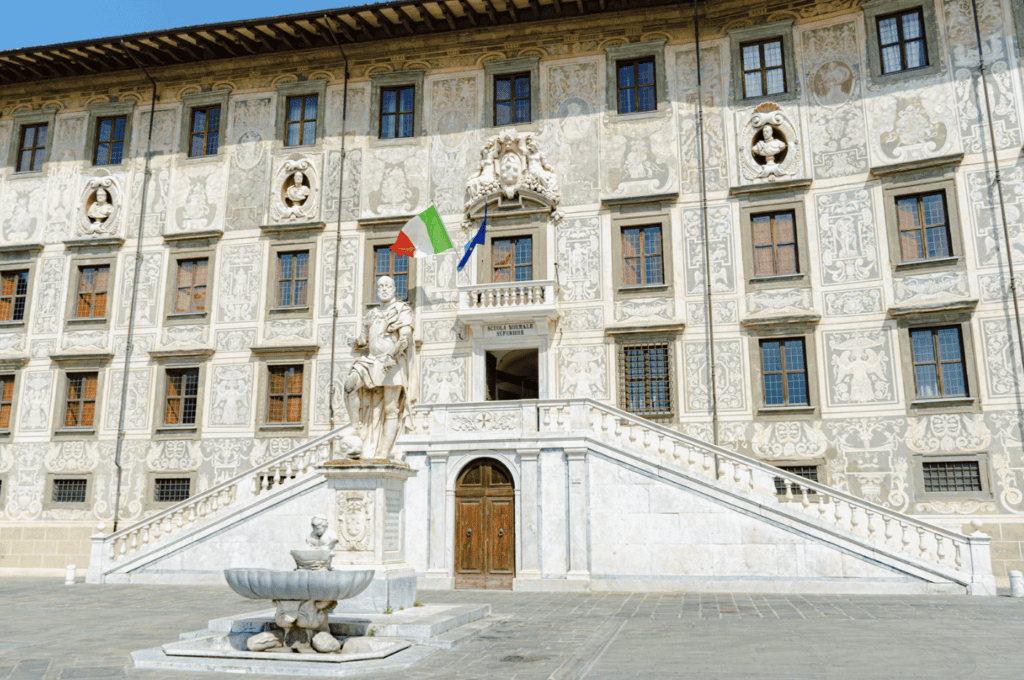
This impressive palace which once now houses the Scuola Normale Superiore, a public university that has produced many notable figures including Nobel prize winners Giocue Carducci (Literature), Carlo Rubbia (Physics), and Enrico Fermi who worked on the Manhattan Project and created the world’s first nuclear reactor.
It now also houses a museum showcasing artifacts and scientific instruments.
🚗🚌🚉 Getting to Pisa
Here’s how long it takes to reach Pisa from various nearby cities by car and train.
- Rome: By car, it’s approximately a 3-hour and 15-minute drive. Train travel takes about 2 hours and 30 minutes.
- Livorno: A quick and convenient option, reachable by car in 25 minutes or by train in just 20 minutes.
- Florence: The train or bus journey from Florence takes around an hour, while driving takes about an hour and 15 minutes.
- Lucca: It is reachable by car in 30 minutes or by train in 35 minutes.
- Tirrenia: This beach resort town is just a 17-minute drive from Pisa, or a 30-minute bus ride.
- Cinque Terre: The Cinque Terre string of villages takes approximately 1 hour and a half by car or train.
So, Is Pisa worth visiting or is it just a tourist trap?
A tourist trap? Well, maybe a little. But if your goal is to learn some fascinating history, walk the streets where Galileo lived, absorb some amazing sights, fabulous art, architecture that will knock your socks off, and have a pistachio cornetto that will change your life, then this is the place for you! Pisa offers a delightful and enriching travel experience for those who want it.
Now that you know what awaits you, put Pisa on your list, and get ready to experience somewhere like nowhere else! And be sure to subscribe so you know when I post new European travel inspiration!
If you liked this post you might also like these other posts on Italian destinations:
- Epic 16-Day Italy Road Trip With Your Dog
- Pompeii vs. Herculaneum: Best Tips & Biggest Differences
- Grand Continental Hotel Tirrenia, Italy: Dog-friendly Review
- What to Do in Ravello for a Day
- Ostuni the White City is Your Gateway to Puglia
- Villa Cimbrone Gardens in Ravello – Heaven on Earth
- Why Matera, the Oldest City in Italy, Will Blow Your Mind
- Ravenna, Italy – Ultimate One-Day Itinerary!
- Traveling with a French Bulldog: Ultimate Summer Packing List
Other City Guides to Hidden Gems in Europe:
- 25 Best Things to Do in Nuremberg: History and Hidden Gems
- 46 Best Things to Do in Rothenburg ob der Tauber
- 21 Best Things to Do in Kaiserslautern Germany
- 11 Best Things to Do in Trier, Germany
- One Day in Aachen? Discover the Treasure!
- 11 Best Things to Do in Marburg, Germany’s Fairytale Town
- The Perfect Weekend in Cologne, Germany
- The 12 Best Things to Do in Epernay France
- 12 Incredible Things to See in Metz, France
- Ostuni the White City: Your Magical Gateway to Puglia
- The 7 Most Amazing Things to Do in Ravello Italy
- Ravenna, Italy – Ultimate One-Day Itinerary!
- 20 Amazing Things to Do in Poznan, Poland!
- Altdorf Switzerland: Discover Where William Tell Shot the Legendary Apple
To get a heads up when we post more city guides and other content about hidden gems in Europe, be sure to subscribe!
